Deana J. Driver's Blog, page 14
November 7, 2014
Remembrance - Bob Elliott and The Little Coat book
Every November, I spend a lot of time thinking about our award-winning, best-selling book
The Little Coat: The Bob and Sue Elliott Story
, written by Saskatchewan author Alan J. Buick. This biography tells the true story of Canadian soldier Bob Elliott, who enlisted in the Second World War in Calgary, Alberta when he was 15 years old. (He told them he was 20.)
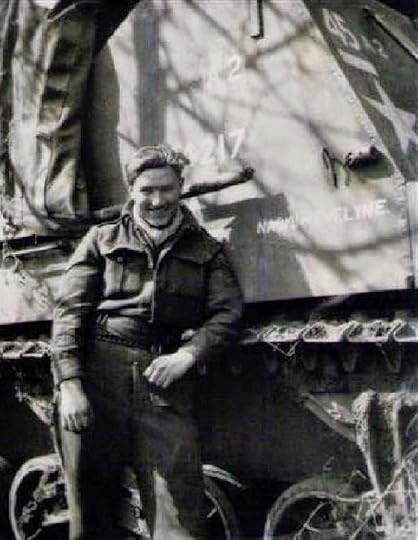 Bob became a tank commander and was fighting the Nazis in the Netherlands, near Alphen en Maas, when he met 10-year-old Sussie Cretier.
Bob became a tank commander and was fighting the Nazis in the Netherlands, near Alphen en Maas, when he met 10-year-old Sussie Cretier.
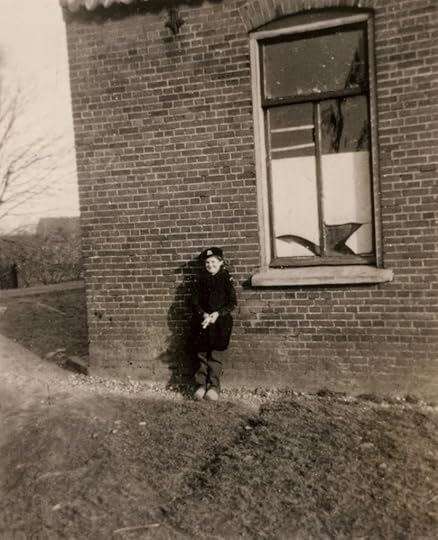
Her real name was Everdina, but her younger brother called her Sussie - which means 'sister' in Dutch - and the nickname stuck.
Sussie's family had escaped to the safety of the Canadian soldiers. Sussie was a feisty little character and she quickly became an adopted little sister and a good-luck charm for the Canadians.
They took her under their wing and decided they would like to give her a Christmas gift. She had a threadbare winter coat, so they took a wool Canadian Army blanket and asked a seamstress in that Dutch village to make the blanket into a coat for Sussie. The soldiers took buttons from their own tunics for the seamstress to use on Sussie's coat.
Bob Elliott, who was already Sussie's hero as the leader of this particular troop, presented the gift to Sussie on Christmas Day 1944.
The coat was the most precious gift she had ever received.
The war ended. Bob returned to Canada. Sussie carried on with life in the Netherlands.
Almost 30 years passed.
Bob travelled to the Netherlands to visit Dutch families he had met during the war, including Sussie's parents. Bob and Sussie reconnected as adults. They fell in love. She still had her little coat. She brought it with her to Canada and married Bob.
 Sue and Bob Elliott with Sue's little coat in the 1980s.The Elliotts lived in Hamilton, Ontario for many years, then moved to Edmonton, Alberta, where they lived for 20 years before moving to the Netherlands permanently so Sue could be near her ailing mother. Before leaving Canada, however, Sue became a member of the Royal Canadian Legion and, alongside Bob, participated in numerous Remembrance Day ceremonies.
Sue and Bob Elliott with Sue's little coat in the 1980s.The Elliotts lived in Hamilton, Ontario for many years, then moved to Edmonton, Alberta, where they lived for 20 years before moving to the Netherlands permanently so Sue could be near her ailing mother. Before leaving Canada, however, Sue became a member of the Royal Canadian Legion and, alongside Bob, participated in numerous Remembrance Day ceremonies.
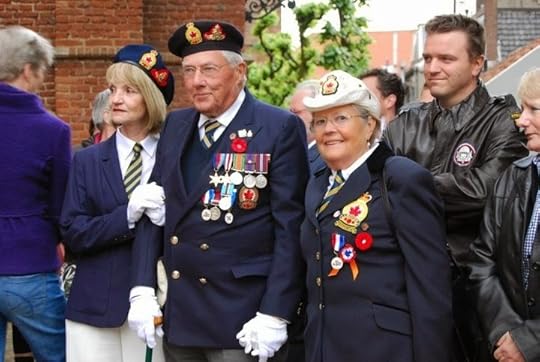
Every year on VE Day in Holland, Bob and Sue would don their uniforms and honour those who had sacrificed so much for the freedom of others. The above photo was taken in the Netherlands in 2009.
Before they left Canada, Bob and Sue donated their special coat to the Royal Canadian Legion branch in Olds, Alberta, where Bob lived as a child. The Legion put the coat in a case and hung it on the wall with other war memorabilia. Alan Buick, a carpenter and singer/songwriter living in Pense, Saskatchewan, was performing one night at the Olds Legion when he started asking questions about the coat. He was delighted to learn that not only were the two people behind the coat alive - but they were married and available to be interviewed!
Alan spent hundreds of hours talking to Bob and Sue by email, by Skype and by letter. He brought his book to DriverWorks Ink in 2009, and I helped him turn it into the award-winning book it is today. (He tells people that I sent him home with three months of work to do on it - which he did, and which made the book even more amazing.)

Watch a video of author Alan Buick talking about his book, The Little Coat .
Our publishing company, DriverWorks Ink, gives back to the community by donating a portion of the proceeds from many of our books to various charities. See the full list on our website. More than $4,000 from The Little Coat books sold has been donated to the Royal Canadian Legion Dominion Command Poppy Trust Fund, which helps veterans and serving members of the military and their families.
Since 2013, $1 from every The Little Coat book sold is being donated to the Canadian War Museum, the new home of the 'child's coat' in this inspiring war story/love story.
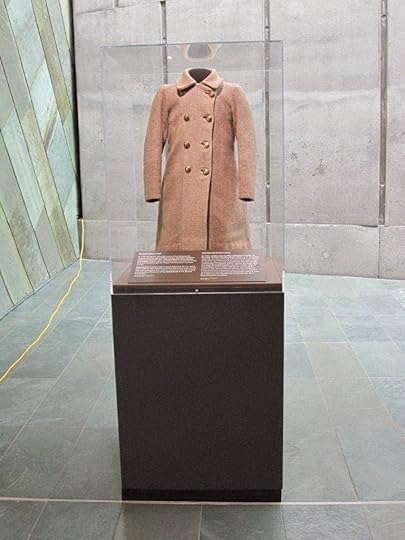
Sadly, our hero Bob Elliott passed away in February 2013, but my husband Al and I were fortunate to visit Normandy in August 2014, and then to meet Sue Elliott in the Netherlands and share in some memories and laughs with this fine lady. She is still as feisty as ever!
We will never forget the sacrifices of Canadian soldiers like Bob Elliott and so many others around the world. They gave much for our freedom.
We all need to be thankful. Not just on Remembrance Day, but every day.
 Bob became a tank commander and was fighting the Nazis in the Netherlands, near Alphen en Maas, when he met 10-year-old Sussie Cretier.
Bob became a tank commander and was fighting the Nazis in the Netherlands, near Alphen en Maas, when he met 10-year-old Sussie Cretier.
Her real name was Everdina, but her younger brother called her Sussie - which means 'sister' in Dutch - and the nickname stuck.
Sussie's family had escaped to the safety of the Canadian soldiers. Sussie was a feisty little character and she quickly became an adopted little sister and a good-luck charm for the Canadians.
They took her under their wing and decided they would like to give her a Christmas gift. She had a threadbare winter coat, so they took a wool Canadian Army blanket and asked a seamstress in that Dutch village to make the blanket into a coat for Sussie. The soldiers took buttons from their own tunics for the seamstress to use on Sussie's coat.
Bob Elliott, who was already Sussie's hero as the leader of this particular troop, presented the gift to Sussie on Christmas Day 1944.
The coat was the most precious gift she had ever received.
The war ended. Bob returned to Canada. Sussie carried on with life in the Netherlands.
Almost 30 years passed.
Bob travelled to the Netherlands to visit Dutch families he had met during the war, including Sussie's parents. Bob and Sussie reconnected as adults. They fell in love. She still had her little coat. She brought it with her to Canada and married Bob.
 Sue and Bob Elliott with Sue's little coat in the 1980s.The Elliotts lived in Hamilton, Ontario for many years, then moved to Edmonton, Alberta, where they lived for 20 years before moving to the Netherlands permanently so Sue could be near her ailing mother. Before leaving Canada, however, Sue became a member of the Royal Canadian Legion and, alongside Bob, participated in numerous Remembrance Day ceremonies.
Sue and Bob Elliott with Sue's little coat in the 1980s.The Elliotts lived in Hamilton, Ontario for many years, then moved to Edmonton, Alberta, where they lived for 20 years before moving to the Netherlands permanently so Sue could be near her ailing mother. Before leaving Canada, however, Sue became a member of the Royal Canadian Legion and, alongside Bob, participated in numerous Remembrance Day ceremonies.
Every year on VE Day in Holland, Bob and Sue would don their uniforms and honour those who had sacrificed so much for the freedom of others. The above photo was taken in the Netherlands in 2009.
Before they left Canada, Bob and Sue donated their special coat to the Royal Canadian Legion branch in Olds, Alberta, where Bob lived as a child. The Legion put the coat in a case and hung it on the wall with other war memorabilia. Alan Buick, a carpenter and singer/songwriter living in Pense, Saskatchewan, was performing one night at the Olds Legion when he started asking questions about the coat. He was delighted to learn that not only were the two people behind the coat alive - but they were married and available to be interviewed!
Alan spent hundreds of hours talking to Bob and Sue by email, by Skype and by letter. He brought his book to DriverWorks Ink in 2009, and I helped him turn it into the award-winning book it is today. (He tells people that I sent him home with three months of work to do on it - which he did, and which made the book even more amazing.)


Watch a video of author Alan Buick talking about his book, The Little Coat .
Our publishing company, DriverWorks Ink, gives back to the community by donating a portion of the proceeds from many of our books to various charities. See the full list on our website. More than $4,000 from The Little Coat books sold has been donated to the Royal Canadian Legion Dominion Command Poppy Trust Fund, which helps veterans and serving members of the military and their families.
Since 2013, $1 from every The Little Coat book sold is being donated to the Canadian War Museum, the new home of the 'child's coat' in this inspiring war story/love story.

Sadly, our hero Bob Elliott passed away in February 2013, but my husband Al and I were fortunate to visit Normandy in August 2014, and then to meet Sue Elliott in the Netherlands and share in some memories and laughs with this fine lady. She is still as feisty as ever!
We will never forget the sacrifices of Canadian soldiers like Bob Elliott and so many others around the world. They gave much for our freedom.
We all need to be thankful. Not just on Remembrance Day, but every day.
Published on November 07, 2014 09:35
October 29, 2014
Authors See Their Books for the First Time
Authors spend months - sometimes years - writing their books. They put their hearts and souls into their work and they work closely with editors and publishers like me to provide the best books they can to potential readers everywhere.
As an author, editor and publisher, one of the most rewarding moments in this process of creating books comes when the author - or, in some cases, illustrator - see their book for the first time. That first moment can be exciting, scary, nerve-wracking, thrilling, rewarding, some combination of those emotions, or so much more.
This year, we assisted several authors and illustrators in creating their new books. We hope you enjoy their reactions to their books.
***
We weren't with Swift Current, Saskatchewan rancher and cowboy poet Bryce Burnett when he opened his first box of Homegrown and other poems books, but we're pretty sure Bryce looked like this when he saw his book for the first time...
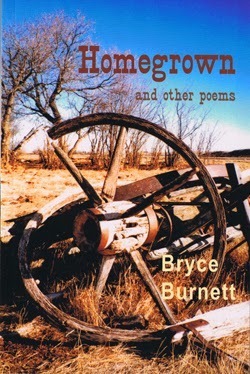
 ... because Bryce is just a happy kind of guy.
... because Bryce is just a happy kind of guy.
 We caught up with Bryce at Swift Current's summer fair. He happily launched his book there and signed autographs for folks as well.
We caught up with Bryce at Swift Current's summer fair. He happily launched his book there and signed autographs for folks as well.
This is Bryce's first book and we are receiving wonderful responses to his poems, which celebrate rural life on the Canadian Prairies, community connections, love, laughter, and spirit and soul. The poems are sometimes funny, sometimes gentle, sometimes enlightening, and always well-written.
* * *
In August, we received two more new books from the printers.
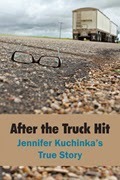
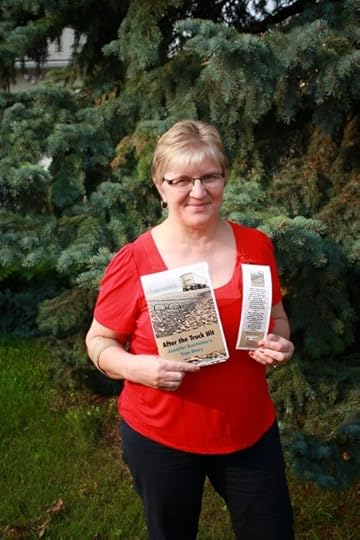 Here I am, holding the book and the bookmark for Jennifer Kuchinka's inspiring memoir,
After the Truck Hit: Jennifer Kuchinka's True Story
.
Here I am, holding the book and the bookmark for Jennifer Kuchinka's inspiring memoir,
After the Truck Hit: Jennifer Kuchinka's True Story
.
The book details Jennifer's recovery from an accident in which she was hit by a semi after she ran out of a hospital onto a highway due to postpartum depression. Jennifer's story is quite incredible. She has recovered to the point that she is back to work as a teacher and is speaking at conferences across Canada to raise awareness of acquired brain injury and of postpartum depression.
When Jennifer received her first shipment of After the Truck Hit books, this first-time author sent us this photo of her reaction:
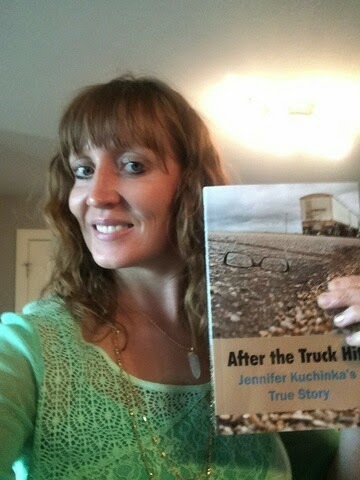 Looks like a pretty proud author. Or a pretty, proud author. (Punctuation is important, but both sentences in this case are accurate - and thus correct.)Jennifer's book is also receiving accolades and is one of the 'Wow!' books we have in our stable of true stories written by Prairie authors.'Wow' is what customers say to us when they hear the book's storyline.
Looks like a pretty proud author. Or a pretty, proud author. (Punctuation is important, but both sentences in this case are accurate - and thus correct.)Jennifer's book is also receiving accolades and is one of the 'Wow!' books we have in our stable of true stories written by Prairie authors.'Wow' is what customers say to us when they hear the book's storyline.
* * *
The second book we received from the printer that particular August day has a special place in our hearts, because it was written by our eldest daughter, Lisa Driver.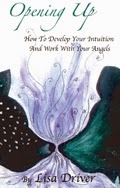
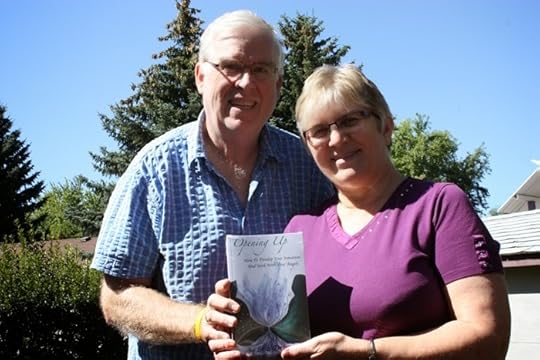
Here are the proud editors/publishers/parents Al and Deana (me) Driver, with Lisa's book, Opening Up: How To Develop Your Intuition And Work With Your Angels. This picture of us was taken by our eldest grandson, who happened to be visiting that day and begged to use my camera to take this important picture from his six-year-old's view of the action.
And what did Lisa, another first-time author, think of her book when she first saw it?
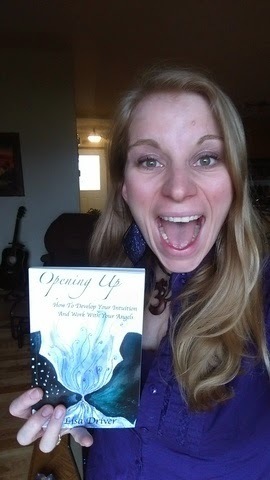 No caption is really necessary for this photo, but let's just say she was happy with it.
No caption is really necessary for this photo, but let's just say she was happy with it.
Lisa's book is the first spiritual wellness book we've produced, and we're happy about the positive response to it and to Lisa's message of health and healing.This is one of the books that we've produced which have prompted people to come to us and say, "I need this book." Well done, Lisa!
* * *
Ten years ago, I met Mary Harelkin Bishop (a Saskatoon, Saskatchewan teacher and award-winning, prolific author) at a self-publishing workshop in Saskatoon. We became instant friends and have worked together on Mary's books Seeds of Hope: A Prairie Story and Moving Forward: The Journey of Paralympian Colette Bourgonje .
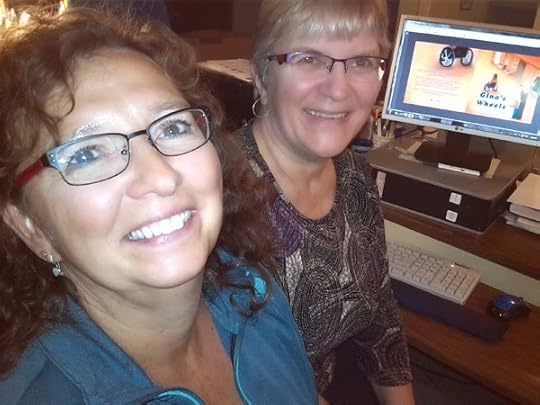 Mary, above left, visited us in July to put the finishing touches on her new children's picture book
Gina's Wheels
, based on a true story related to a girl who met Canadian Paralympian Colette Bourgonje.Mary and I always have fun when we're working together, as you can tell by the big grins on our faces.
Mary, above left, visited us in July to put the finishing touches on her new children's picture book
Gina's Wheels
, based on a true story related to a girl who met Canadian Paralympian Colette Bourgonje.Mary and I always have fun when we're working together, as you can tell by the big grins on our faces.
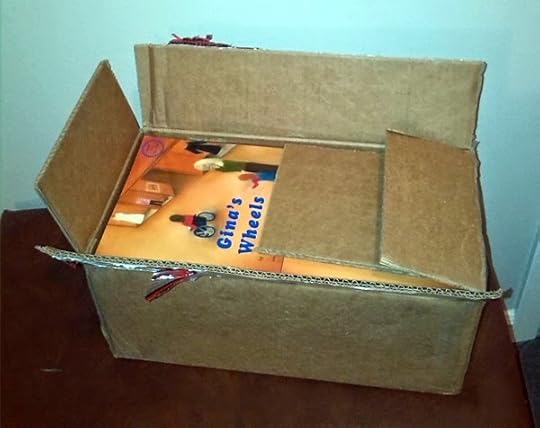
When Gina's Wheels arrived from the printers' shop, this was Mary's reaction:
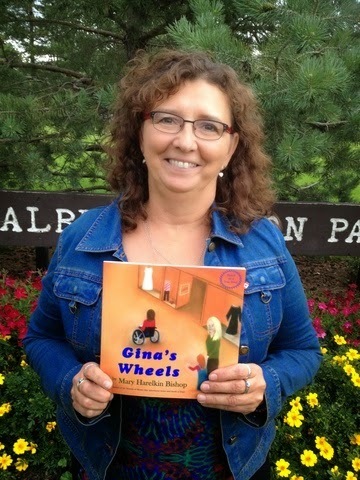 "Just picked up my books. They look wonderful!" she told us.
"Just picked up my books. They look wonderful!" she told us.
We're pleased. The book tells a great story with a wonderful lesson of tolerance and acceptance of others. A clerk in a bookstore told us, "This book needs to exist." We heartily agree.
Gina's Wheels was illustrated by Saskatoon artist Diane L. Greenhorn, with chalk drawings. Nice, huh?
* * *
The fifth book we published in the past few months is Jamie and the Monster Bookroom, a children's picture book by Kerry Simpson and Jamie Simpson, illustrated by Regina artist Erika Folnović. It's about a little girl who loves the library and reading, and has a marvelous adventure in one of the rooms of her local library.
Here's the book and bookmark: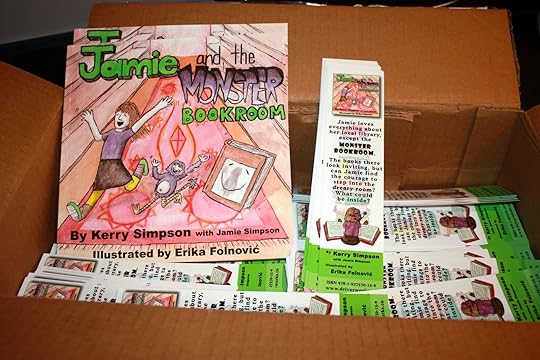
And here is how artist Erika Folnović reacted when we showed her the printed book: Nervous ...
Nervous ...
 ... and then happy.
... and then happy.
But really , Erika? That's your reaction?
Come on, girl.Show us how you really feel about the finished book.
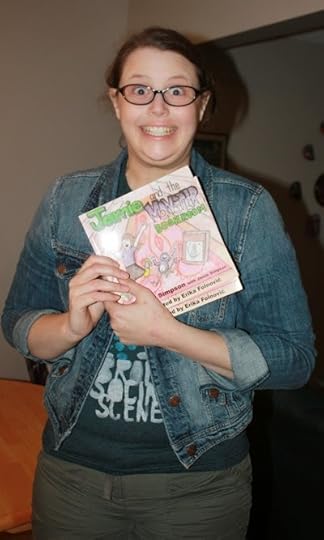 There you go.
That's
the Erika we know and love!
There you go.
That's
the Erika we know and love!
(Erika also created the cover and inside illustrations of our award-winning humour book Letters to Jennifer from Maudie & Oliver by Sharon Gray, by the way.)
At the launch of Jamie and the Monster Bookroom in Regina, Saskatchewan a few days later, we asked author Kerry Simpson to show us her response when she saw the book for the first time:
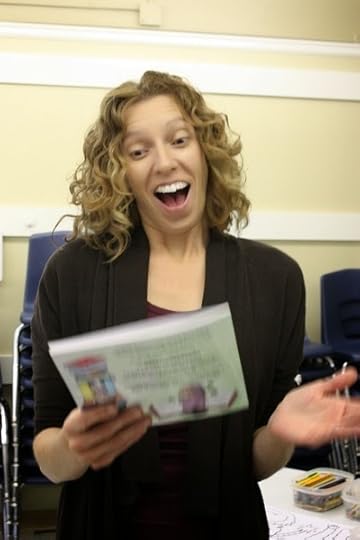 Thrilled.
Thrilled.
Nice.
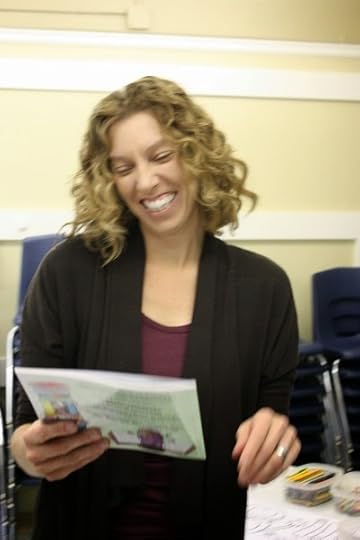 Definitely another happy, first-time author.
Definitely another happy, first-time author.
***
So there you are, folks. We hope you enjoyed these glimpses into some of the special moments in our publishing lives.
We look forward to adding more of them to our list, as we help authors create more stories for your reading enjoyment.
We invite you to talk to us about how we can help you publish your first book. Check here for more details.
Until then, take care.
As an author, editor and publisher, one of the most rewarding moments in this process of creating books comes when the author - or, in some cases, illustrator - see their book for the first time. That first moment can be exciting, scary, nerve-wracking, thrilling, rewarding, some combination of those emotions, or so much more.
This year, we assisted several authors and illustrators in creating their new books. We hope you enjoy their reactions to their books.
***
We weren't with Swift Current, Saskatchewan rancher and cowboy poet Bryce Burnett when he opened his first box of Homegrown and other poems books, but we're pretty sure Bryce looked like this when he saw his book for the first time...

 ... because Bryce is just a happy kind of guy.
... because Bryce is just a happy kind of guy. We caught up with Bryce at Swift Current's summer fair. He happily launched his book there and signed autographs for folks as well.
We caught up with Bryce at Swift Current's summer fair. He happily launched his book there and signed autographs for folks as well.This is Bryce's first book and we are receiving wonderful responses to his poems, which celebrate rural life on the Canadian Prairies, community connections, love, laughter, and spirit and soul. The poems are sometimes funny, sometimes gentle, sometimes enlightening, and always well-written.
* * *
In August, we received two more new books from the printers.

 Here I am, holding the book and the bookmark for Jennifer Kuchinka's inspiring memoir,
After the Truck Hit: Jennifer Kuchinka's True Story
.
Here I am, holding the book and the bookmark for Jennifer Kuchinka's inspiring memoir,
After the Truck Hit: Jennifer Kuchinka's True Story
. The book details Jennifer's recovery from an accident in which she was hit by a semi after she ran out of a hospital onto a highway due to postpartum depression. Jennifer's story is quite incredible. She has recovered to the point that she is back to work as a teacher and is speaking at conferences across Canada to raise awareness of acquired brain injury and of postpartum depression.
When Jennifer received her first shipment of After the Truck Hit books, this first-time author sent us this photo of her reaction:
 Looks like a pretty proud author. Or a pretty, proud author. (Punctuation is important, but both sentences in this case are accurate - and thus correct.)Jennifer's book is also receiving accolades and is one of the 'Wow!' books we have in our stable of true stories written by Prairie authors.'Wow' is what customers say to us when they hear the book's storyline.
Looks like a pretty proud author. Or a pretty, proud author. (Punctuation is important, but both sentences in this case are accurate - and thus correct.)Jennifer's book is also receiving accolades and is one of the 'Wow!' books we have in our stable of true stories written by Prairie authors.'Wow' is what customers say to us when they hear the book's storyline.* * *
The second book we received from the printer that particular August day has a special place in our hearts, because it was written by our eldest daughter, Lisa Driver.


Here are the proud editors/publishers/parents Al and Deana (me) Driver, with Lisa's book, Opening Up: How To Develop Your Intuition And Work With Your Angels. This picture of us was taken by our eldest grandson, who happened to be visiting that day and begged to use my camera to take this important picture from his six-year-old's view of the action.
And what did Lisa, another first-time author, think of her book when she first saw it?
 No caption is really necessary for this photo, but let's just say she was happy with it.
No caption is really necessary for this photo, but let's just say she was happy with it.Lisa's book is the first spiritual wellness book we've produced, and we're happy about the positive response to it and to Lisa's message of health and healing.This is one of the books that we've produced which have prompted people to come to us and say, "I need this book." Well done, Lisa!
* * *
Ten years ago, I met Mary Harelkin Bishop (a Saskatoon, Saskatchewan teacher and award-winning, prolific author) at a self-publishing workshop in Saskatoon. We became instant friends and have worked together on Mary's books Seeds of Hope: A Prairie Story and Moving Forward: The Journey of Paralympian Colette Bourgonje .
 Mary, above left, visited us in July to put the finishing touches on her new children's picture book
Gina's Wheels
, based on a true story related to a girl who met Canadian Paralympian Colette Bourgonje.Mary and I always have fun when we're working together, as you can tell by the big grins on our faces.
Mary, above left, visited us in July to put the finishing touches on her new children's picture book
Gina's Wheels
, based on a true story related to a girl who met Canadian Paralympian Colette Bourgonje.Mary and I always have fun when we're working together, as you can tell by the big grins on our faces.
When Gina's Wheels arrived from the printers' shop, this was Mary's reaction:
 "Just picked up my books. They look wonderful!" she told us.
"Just picked up my books. They look wonderful!" she told us.We're pleased. The book tells a great story with a wonderful lesson of tolerance and acceptance of others. A clerk in a bookstore told us, "This book needs to exist." We heartily agree.
Gina's Wheels was illustrated by Saskatoon artist Diane L. Greenhorn, with chalk drawings. Nice, huh?
* * *
The fifth book we published in the past few months is Jamie and the Monster Bookroom, a children's picture book by Kerry Simpson and Jamie Simpson, illustrated by Regina artist Erika Folnović. It's about a little girl who loves the library and reading, and has a marvelous adventure in one of the rooms of her local library.
Here's the book and bookmark:

And here is how artist Erika Folnović reacted when we showed her the printed book:
 Nervous ...
Nervous ... ... and then happy.
... and then happy.But really , Erika? That's your reaction?
Come on, girl.Show us how you really feel about the finished book.
 There you go.
That's
the Erika we know and love!
There you go.
That's
the Erika we know and love!(Erika also created the cover and inside illustrations of our award-winning humour book Letters to Jennifer from Maudie & Oliver by Sharon Gray, by the way.)
At the launch of Jamie and the Monster Bookroom in Regina, Saskatchewan a few days later, we asked author Kerry Simpson to show us her response when she saw the book for the first time:
 Thrilled.
Thrilled. Nice.
 Definitely another happy, first-time author.
Definitely another happy, first-time author.***
So there you are, folks. We hope you enjoyed these glimpses into some of the special moments in our publishing lives.
We look forward to adding more of them to our list, as we help authors create more stories for your reading enjoyment.
We invite you to talk to us about how we can help you publish your first book. Check here for more details.
Until then, take care.
Published on October 29, 2014 20:56
October 7, 2014
A Birthday, 2 Book Signings, A Book Sale, A Book Launch - Our Happy Thanksgiving!
This coming weekend is Thanksgiving weekend in Canada, and we at DriverWorks Ink publishing are ever thankful for all the great events happening in our lives every day, but for this week in particular.
Today, October 7th, is a special day for a very special woman :
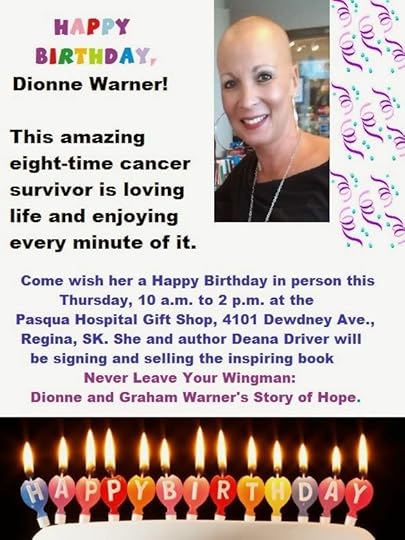
Dionne and I will be signing our hope-filled Never Leave Your Wingman book this Thursday, October 9, at the Pasqua Hospital in Regina, Saskatchewan, in the foyer - so stop by for a free hug if you're in town!
This Saturday, October 11, there are two important events happening for us and our books.
Jennfier Kuchinka, who survived being hit by a semi after she ran out of a hospital and onto a highway, is signing her After the Truck Hit book at Coles in the Northgate Mall, Regina, SK.
[image error]
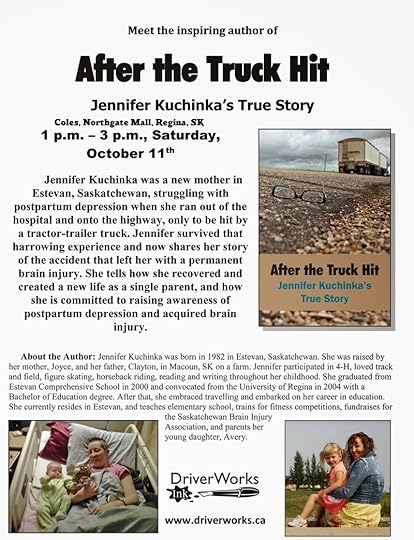
And my husband and publishing partner, Al Driver, and I will spend most of the day at a craft show in Central Butte, Saskatchewan. It's their Festival of Creative Crafts and Trades - and Oktoberfest! Yes!
At the Central Butte Arena, Central Butte, SK.
Craft show and sale 11 a.m. - 4 p.m., supper 5 - 7pm, followed by dance.
23rd annual show and sale of crafts and trades in junction with
Central Butte Recreation Board's Oktoberfest. Event features a variety of creative work and commercial exhibits. Food court.
Then on Sunday, October 12, we're hosting the Regina launch of Opening Up , written by our daughter Lisa Driver, an angel reader and spiritual healer:
That Sunday night, we're having our Thanksgiving celebration with family.
On Monday, we're putting our feet up and trying not to answer the phone.
Yeah, that never happens.
HAPPY THANKSGIVING, everyone!
Today, October 7th, is a special day for a very special woman :

Dionne and I will be signing our hope-filled Never Leave Your Wingman book this Thursday, October 9, at the Pasqua Hospital in Regina, Saskatchewan, in the foyer - so stop by for a free hug if you're in town!
This Saturday, October 11, there are two important events happening for us and our books.
Jennfier Kuchinka, who survived being hit by a semi after she ran out of a hospital and onto a highway, is signing her After the Truck Hit book at Coles in the Northgate Mall, Regina, SK.
[image error]

And my husband and publishing partner, Al Driver, and I will spend most of the day at a craft show in Central Butte, Saskatchewan. It's their Festival of Creative Crafts and Trades - and Oktoberfest! Yes!
At the Central Butte Arena, Central Butte, SK.
Craft show and sale 11 a.m. - 4 p.m., supper 5 - 7pm, followed by dance.
23rd annual show and sale of crafts and trades in junction with
Central Butte Recreation Board's Oktoberfest. Event features a variety of creative work and commercial exhibits. Food court.
Then on Sunday, October 12, we're hosting the Regina launch of Opening Up , written by our daughter Lisa Driver, an angel reader and spiritual healer:

That Sunday night, we're having our Thanksgiving celebration with family.
On Monday, we're putting our feet up and trying not to answer the phone.
Yeah, that never happens.
HAPPY THANKSGIVING, everyone!
Published on October 07, 2014 13:50
October 1, 2014
Authors - Don't Sweat the Small Stuff
I love working with authors who care about their written work. I care deeply about the words I write and the words we publish, so I would not be happy working with someone who was not passionate about the words they place together.
Lately, I've been noticing a number of authors and would-be authors who are prone to apologize.
"There are still errors," some will say about their manuscript, with a deep sigh as if they've committed a crime.
"I think I caught all the typos, but I'm not sure," others will tell me, with apologetic puppy-dog eyes.
As an author who is also an editor and publisher, I have a unique perspective on feeling the angst from all sides of this process called book publishing. While I spend countless hours editing, rewriting and touching up my own manuscripts before editors and proofreaders see them, I also know what it feels like to have someone else point out a mistake in my writing.
So to would-be authors everywhere, please remember these words:
Don't Sweat the Small Stuff
When you give your manuscript to an editor, acknowledge to yourself that:There will probably be typos. There will probably be words missing from sentences. There will probably be words used incorrectly in a sentence.There may be incorrect punctuation marks.There may even be a section of the story that belongs in a different spot in the manuscript.Why does this happen?
Because we're human. And because writing and publishing are subjective exercises in which individual expression and experience are paramount.
Writers' brains often work faster than their fingers do when typing, and we sometimes miss typing some words that we know ought to be in a sentence. One of our former newspaper colleagues is known to emit the ' 'nt ' on words - which is a serious error when you're telling readers about another person's position on a topic. 'The leader is going to run for political office again' is significantly different from 'The leader isn't going to run for political office again'.
Also, when we proofread our work, our brains can sometimes read words into sentences that actually don't exist in the written document. We think they're there because we know we wanted them to be there, but we accidentally forgot to type them into the document.
Also, computers incorrectly auto-correct words and we humans don't always catch those errors when reading a long document for content versus reading it for spelling.
As for incorrect usage, punctuation and placement of pieces within the story - those are some of the sticky points that crop up between a writer and an editor. While there are set rules for sentence structure and punctuation, editors (and publishing houses) differ in their knowledge levels and writing style preferences.
So please give yourself a break. Accept that you are not perfect ... and neither is anyone else.
Find a good editor. Do your best to work together to make the document or book as good as you both can.
Then leave it to the reader and move on to your next project.
That's right. Move on.
We are creators. We must create. Always.
So stop stewing and go make more stew... word-wise, I mean.
Have a great rest of the day!
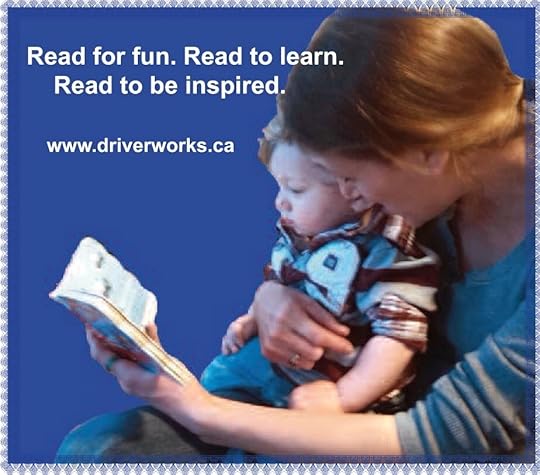
Lately, I've been noticing a number of authors and would-be authors who are prone to apologize.
"There are still errors," some will say about their manuscript, with a deep sigh as if they've committed a crime.
"I think I caught all the typos, but I'm not sure," others will tell me, with apologetic puppy-dog eyes.
As an author who is also an editor and publisher, I have a unique perspective on feeling the angst from all sides of this process called book publishing. While I spend countless hours editing, rewriting and touching up my own manuscripts before editors and proofreaders see them, I also know what it feels like to have someone else point out a mistake in my writing.
So to would-be authors everywhere, please remember these words:
Don't Sweat the Small Stuff
When you give your manuscript to an editor, acknowledge to yourself that:There will probably be typos. There will probably be words missing from sentences. There will probably be words used incorrectly in a sentence.There may be incorrect punctuation marks.There may even be a section of the story that belongs in a different spot in the manuscript.Why does this happen?
Because we're human. And because writing and publishing are subjective exercises in which individual expression and experience are paramount.
Writers' brains often work faster than their fingers do when typing, and we sometimes miss typing some words that we know ought to be in a sentence. One of our former newspaper colleagues is known to emit the ' 'nt ' on words - which is a serious error when you're telling readers about another person's position on a topic. 'The leader is going to run for political office again' is significantly different from 'The leader isn't going to run for political office again'.
Also, when we proofread our work, our brains can sometimes read words into sentences that actually don't exist in the written document. We think they're there because we know we wanted them to be there, but we accidentally forgot to type them into the document.
Also, computers incorrectly auto-correct words and we humans don't always catch those errors when reading a long document for content versus reading it for spelling.
As for incorrect usage, punctuation and placement of pieces within the story - those are some of the sticky points that crop up between a writer and an editor. While there are set rules for sentence structure and punctuation, editors (and publishing houses) differ in their knowledge levels and writing style preferences.
So please give yourself a break. Accept that you are not perfect ... and neither is anyone else.
Find a good editor. Do your best to work together to make the document or book as good as you both can.
Then leave it to the reader and move on to your next project.
That's right. Move on.
We are creators. We must create. Always.
So stop stewing and go make more stew... word-wise, I mean.
Have a great rest of the day!

Published on October 01, 2014 21:09
September 18, 2014
The Best Introduction I've Ever Received
Having spent most of my adult life as a freelance journalist who has listened to numerous speeches of others, I have had to adjust my mindset considerably since I became an author in 2001 and began giving speeches about my books. I usually talk about my background a bit, then get into my writing history and focus on one or two books, depending on the audience and their initial request of me.
Instead of asking the questions, I am now attempting to answer them - during and after my presentations. Instead of listening to others being introduced, I am hearing how others introduce me.
Usually, they take information from the About Us page of our website and add a couple of lines.
That is not what happened in Swift Current, Saskatchewan on September 17, 2014.
Several months ago, I was contacted by Betty McDougall, chairperson of the Write Out Loud Committee in Swift Current, to see if I would be willing to speak at their Write Out Loud event, which is part of the regular programming for the Southwest Cultural Development Group (Lyric Theatre). They wanted me to talk about writing the Never Leave Your Wingman book, my work as an author and perhaps even a bit of information about my work as a publisher.
I agreed and confirmed that Al, my husband and DriverWorks Ink publishing partner, could come as well to sell our books to anyone who was interested in purchasing them. And so it was settled.
On September 17, Al and I arrived in Swift Current and met Betty McDougall and another committee member, Terry Toews, for supper before the event. We had a great visit and, as most Prairie people do, we quickly became comfortable with each other and were laughing and telling stories in no time.
After supper, we drove to the historic Lyric Theatre building in downtown Swift Current, and took a few photos of the poster announcing my speech/reading.
One of the committee members kindly made some adjustments to the book's cover ...
 ... to get all the information in for the evening event.
... to get all the information in for the evening event.
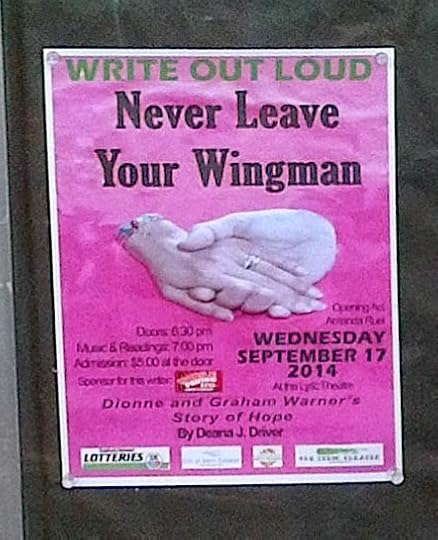
We also took a couple photos of me with the sign outside the theatre, which hosts local artists, including a husband/wife musician team who performed before my reading. They were the opening act, if you will.

While Al and I were setting up our table of books inside, people were flocking over to look at our numerous titles and purchasing numerous books before Al could even get them all out of the boxes. We were thrilled! (Thank you, Swift Current! You are the best!)
After the opening act, it was time for Terry Toews to introduce me.
This is what she said:
INTRODUCTION
It is my pleasure this evening to introduce the first author for our brand new Write Out Loud season.
Deana Driver is an author, editor, book publisher and freelance journalist based in Regina. She is the author of five non-fiction books and the founding partner of DriverWorks Ink publishing, which specializes in non-fiction stories, and helps authors self-publish their work. It is of special interest to us that DriverWorks recently published Bryce Burnett’s first book of cowboy poetry, Homegrown and Other Poems .
Since 1983, she has published more than 2,000 articles (while raising three kids - so she's kind of an underachiever), in addition to her non-fiction books. Her latest release is also her first children’s book. The Sailor and the Christmas Trees is the true story of a Manitoba sailor who cut down trees in Newfoundland, hid them on his ship, and surprised his shipmates and some small English children while at sea during the Second World War.
Ms. Driver has a passion for sharing the stories of fascinating Prairie people and unsung Canadian heroes. She enjoys speaking to audiences of all ages, and uses her own experiences and those of people she has interviewed to show the importance of reading and writing as the path to learning and a better future.
When I read Never Leave Your Wingman, I was impressed by the degree to which Deana Driver is willing to take a back seat to the story she is telling. Throughout the book, I was thinking about introducing Deana and what I would say about her, and then I would realize that I was accidentally introducing Dionne Warner in my imagination, so successfully has Deana written herself out of the book! It takes real skill and a willing sublimation of ego to be able to do that.
The fact that the book is definitely Dionne’s story says a lot about Deana Driver. It tells me that she is dedicated to giving these unsung heroes their own voice, without imposing her voice or value judgments. It tells me that she is secure enough to be willing to disappear into a story in order to be able to tell it with authenticity, and it tells me that she is, herself, something of an unsung hero.
It is no small thing to want to tell the stories of prairie folks and amazing people who otherwise escape the notice of the world. And it is no small thing to want to help other writers move forward with their work. When I came to the end of Never Leave Your Wingman, I concluded that it was no accident that Ms. Driver wanted to write about Dionne Warner. In many ways, they are cut from the same cloth, in their willingness to help others and their responsiveness to reactions and emotions that sometimes go unnoticed by others.
We are very fortunate to have Deana Driver with us tonight. Please join me in welcoming her to the Write Out Loud stage.
Wow. That was very high praise ... and I was a little taken aback.
Last fall, during our large tour of schools and libraries in which I made 62 presentations in 27 communities across the Prairie provinces, a high school teacher in Prince Albert introduced me as 'a humanitarian' - and I was thrilled and honoured with that reference.
In Swift Current, with Terry's introduction, I had never heard so many kind words about my work, my writing, or my person from someone who had never met me before.
Her introduction made me a little emotional ... which led to a rather emotional speech about a very emotional topic - the amazing eight-time cancer survivor Dionne Warner and fighting cancer with laughter, courage, and above all, hope.
I calmed down after a few minutes and by the end of my ad-libbed speech, the audience had heard a bit about my own story, plus some excerpts from the book, some background to those excerpts, and more. One woman kindly told us later that she "could have listened to that all night. Dionne's story is great, but to hear how Deana went from freelance writing to publishing was really good. And when she started talking about the different books, I could have listened to that about each one of them.
Some of these authors just come and read from their book. This was really entertaining - but more than that, it was educational, too."
So to all you authors out there, please add those extra touches to your readings. Tell the audience something they won't read in the book. Who are you and why do you write? Where did the story idea come from for this book? What is your favourite part of the book? Was one part more difficult to write than another? It's all about engaging the reader, at every level.
Swift Current's Write Out Loud was an amazing experience and Al and I are so grateful to have been invited, welcomed, and appreciated by these wonderful Prairie people.
Thank you, Betty, for inviting me to speak at Write Out Loud and thank you, Terry, for that remarkable introduction. It's the best!
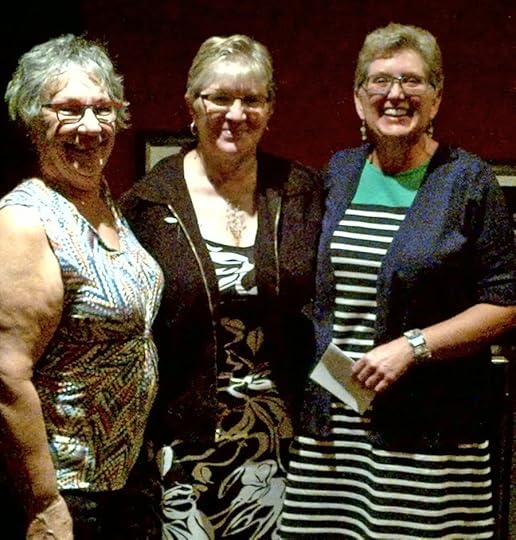 (L to r) Betty McDougall, Deana Driver, Terry Toews - Sept. 17, 2014.
(L to r) Betty McDougall, Deana Driver, Terry Toews - Sept. 17, 2014.
Instead of asking the questions, I am now attempting to answer them - during and after my presentations. Instead of listening to others being introduced, I am hearing how others introduce me.
Usually, they take information from the About Us page of our website and add a couple of lines.
That is not what happened in Swift Current, Saskatchewan on September 17, 2014.
Several months ago, I was contacted by Betty McDougall, chairperson of the Write Out Loud Committee in Swift Current, to see if I would be willing to speak at their Write Out Loud event, which is part of the regular programming for the Southwest Cultural Development Group (Lyric Theatre). They wanted me to talk about writing the Never Leave Your Wingman book, my work as an author and perhaps even a bit of information about my work as a publisher.
I agreed and confirmed that Al, my husband and DriverWorks Ink publishing partner, could come as well to sell our books to anyone who was interested in purchasing them. And so it was settled.
On September 17, Al and I arrived in Swift Current and met Betty McDougall and another committee member, Terry Toews, for supper before the event. We had a great visit and, as most Prairie people do, we quickly became comfortable with each other and were laughing and telling stories in no time.
After supper, we drove to the historic Lyric Theatre building in downtown Swift Current, and took a few photos of the poster announcing my speech/reading.
One of the committee members kindly made some adjustments to the book's cover ...
 ... to get all the information in for the evening event.
... to get all the information in for the evening event.

We also took a couple photos of me with the sign outside the theatre, which hosts local artists, including a husband/wife musician team who performed before my reading. They were the opening act, if you will.

While Al and I were setting up our table of books inside, people were flocking over to look at our numerous titles and purchasing numerous books before Al could even get them all out of the boxes. We were thrilled! (Thank you, Swift Current! You are the best!)
After the opening act, it was time for Terry Toews to introduce me.
This is what she said:
INTRODUCTION
It is my pleasure this evening to introduce the first author for our brand new Write Out Loud season.
Deana Driver is an author, editor, book publisher and freelance journalist based in Regina. She is the author of five non-fiction books and the founding partner of DriverWorks Ink publishing, which specializes in non-fiction stories, and helps authors self-publish their work. It is of special interest to us that DriverWorks recently published Bryce Burnett’s first book of cowboy poetry, Homegrown and Other Poems .
Since 1983, she has published more than 2,000 articles (while raising three kids - so she's kind of an underachiever), in addition to her non-fiction books. Her latest release is also her first children’s book. The Sailor and the Christmas Trees is the true story of a Manitoba sailor who cut down trees in Newfoundland, hid them on his ship, and surprised his shipmates and some small English children while at sea during the Second World War.
Ms. Driver has a passion for sharing the stories of fascinating Prairie people and unsung Canadian heroes. She enjoys speaking to audiences of all ages, and uses her own experiences and those of people she has interviewed to show the importance of reading and writing as the path to learning and a better future.
When I read Never Leave Your Wingman, I was impressed by the degree to which Deana Driver is willing to take a back seat to the story she is telling. Throughout the book, I was thinking about introducing Deana and what I would say about her, and then I would realize that I was accidentally introducing Dionne Warner in my imagination, so successfully has Deana written herself out of the book! It takes real skill and a willing sublimation of ego to be able to do that.
The fact that the book is definitely Dionne’s story says a lot about Deana Driver. It tells me that she is dedicated to giving these unsung heroes their own voice, without imposing her voice or value judgments. It tells me that she is secure enough to be willing to disappear into a story in order to be able to tell it with authenticity, and it tells me that she is, herself, something of an unsung hero.
It is no small thing to want to tell the stories of prairie folks and amazing people who otherwise escape the notice of the world. And it is no small thing to want to help other writers move forward with their work. When I came to the end of Never Leave Your Wingman, I concluded that it was no accident that Ms. Driver wanted to write about Dionne Warner. In many ways, they are cut from the same cloth, in their willingness to help others and their responsiveness to reactions and emotions that sometimes go unnoticed by others.
We are very fortunate to have Deana Driver with us tonight. Please join me in welcoming her to the Write Out Loud stage.
Wow. That was very high praise ... and I was a little taken aback.
Last fall, during our large tour of schools and libraries in which I made 62 presentations in 27 communities across the Prairie provinces, a high school teacher in Prince Albert introduced me as 'a humanitarian' - and I was thrilled and honoured with that reference.
In Swift Current, with Terry's introduction, I had never heard so many kind words about my work, my writing, or my person from someone who had never met me before.
Her introduction made me a little emotional ... which led to a rather emotional speech about a very emotional topic - the amazing eight-time cancer survivor Dionne Warner and fighting cancer with laughter, courage, and above all, hope.
I calmed down after a few minutes and by the end of my ad-libbed speech, the audience had heard a bit about my own story, plus some excerpts from the book, some background to those excerpts, and more. One woman kindly told us later that she "could have listened to that all night. Dionne's story is great, but to hear how Deana went from freelance writing to publishing was really good. And when she started talking about the different books, I could have listened to that about each one of them.
Some of these authors just come and read from their book. This was really entertaining - but more than that, it was educational, too."
So to all you authors out there, please add those extra touches to your readings. Tell the audience something they won't read in the book. Who are you and why do you write? Where did the story idea come from for this book? What is your favourite part of the book? Was one part more difficult to write than another? It's all about engaging the reader, at every level.
Swift Current's Write Out Loud was an amazing experience and Al and I are so grateful to have been invited, welcomed, and appreciated by these wonderful Prairie people.
Thank you, Betty, for inviting me to speak at Write Out Loud and thank you, Terry, for that remarkable introduction. It's the best!
 (L to r) Betty McDougall, Deana Driver, Terry Toews - Sept. 17, 2014.
(L to r) Betty McDougall, Deana Driver, Terry Toews - Sept. 17, 2014.
Published on September 18, 2014 19:01
September 15, 2014
My Pens from Europe - 2
'The pen is mightier than the sword.' This is my second of two blogs about the souvenir pens I bought while in Europe last summer, and it was Al's idea to start this blog with that old familiar saying. Since I am a writer who dislikes fighting and believes we can truly heal the world through written words, the saying seems to fit, so I went with it.
After a wonderful time in Nice and Monaco last summer, we travelled to Barcelona. We would have loved to stay there longer, but maybe we'll do that next time.

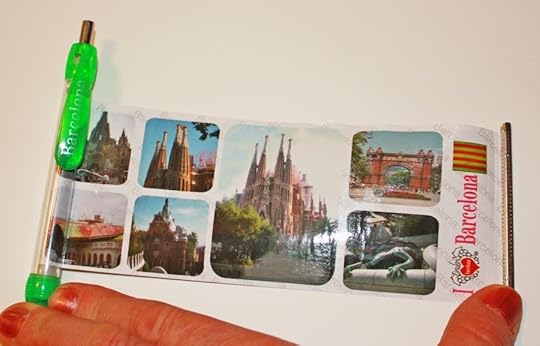 This pen has a great pull-out strip that has photos on both sides, featuring various sites of Barcelona and area.
This pen has a great pull-out strip that has photos on both sides, featuring various sites of Barcelona and area.

Oh my gosh, Paris was next! We LOVED Paris. It was the best experience with so many beautiful sites and experiences. We bought this pen at the Vincent Van Gogh Museum. It is the most unique-looking pen we purchased.
We bought this pen at the Vincent Van Gogh Museum. It is the most unique-looking pen we purchased.

 At the Eiffel Tower, I bought this pen...
At the Eiffel Tower, I bought this pen...
 ... it lights up, just like the tower.
... it lights up, just like the tower.


At the gift shop on the second level of the Eiffel Tower, I couldn't resist this pen that names some of the historic sites in Paris.




Mont Saint Michel is a fascinating island in France, and we met another author while there.


The day we spent in the Normandy area of France was one of the most significant days of our travels. We walked on Juno Beach, and set a copy of Alan Buick's book The Little Coat - a true story of an Alberta soldier and a little Dutch girl - down on the sand at that historic spot.
We couldn't find a pen to purchase at any of the spots we visited in Normandy. Frankly, we didn't look too hard either. We were far more interested in the history, and too overwhelmed in absorbing the pain and the emotion of those places. What a feeling it was to view those sites in person, to see those many, many graves, and to honour those who have fallen for our freedom.
We travelled to Belgium next. Bruges is very pretty. We would have liked another day or two to explore that city.


But we had a couple of very important stops that we wanted to make in the Netherlands, so we had to keep going.
Our first stop was the National Liberation Museum in Groesbeek, Netherlands.

 A parachute sits on the outside of the museum building, and the parachute on the pen goes up and down as you move the pen.
A parachute sits on the outside of the museum building, and the parachute on the pen goes up and down as you move the pen.

We saw a special exhibition that featured Sue Elliott, the subject of our The Little Coat book.Then we met the amazing and still feisty Sue Elliott. Incredible.
We went on to Amsterdam and enjoyed those days a lot as well.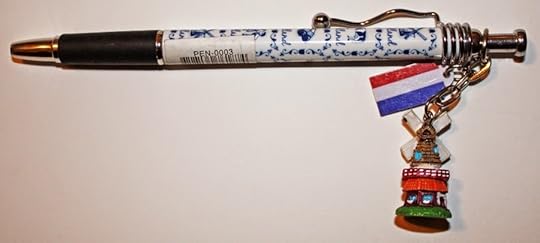

Back into Germany, Berlin was next on our list.


We were attracted to this dark, strong pen from Germany.


I fell in love with the Ampelmann (please forgive the written misspelling below), and had to buy a green and a red version of this popular figure displayed on pedestrian walk signals there.

We felt the war in Prague, Czech Republic, and we loved this historic city.

Back into Germany now, we visited the site of the Dachau Concentration Camp. Nothing but pain and sadness came from that site. We were glad to move on.
To a happy, elaborate, over-the-top set of castles at Fussen.


This pen from Switzerland was a challenge to find. But it was worth it. Look at this beauty...

Then we stayed in Colmar, France - just down the street from the Statue of Liberty.



 The stork is a symbol of the region.
The stork is a symbol of the region.
This was the hotel we stayed at in Frankfurt before flying back to Canada.

So this is my collection of pens from Europe. I can't wait to use them all in my writing for years to come ... and to add to them the next time we travel to Europe.
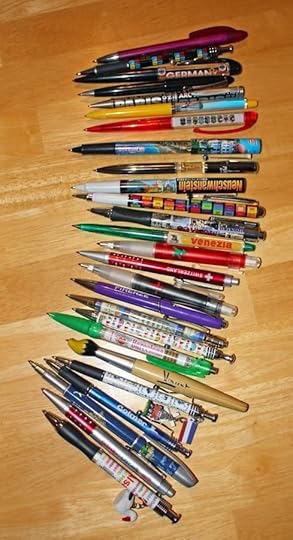
After a wonderful time in Nice and Monaco last summer, we travelled to Barcelona. We would have loved to stay there longer, but maybe we'll do that next time.

 This pen has a great pull-out strip that has photos on both sides, featuring various sites of Barcelona and area.
This pen has a great pull-out strip that has photos on both sides, featuring various sites of Barcelona and area.

Oh my gosh, Paris was next! We LOVED Paris. It was the best experience with so many beautiful sites and experiences.
 We bought this pen at the Vincent Van Gogh Museum. It is the most unique-looking pen we purchased.
We bought this pen at the Vincent Van Gogh Museum. It is the most unique-looking pen we purchased.
 At the Eiffel Tower, I bought this pen...
At the Eiffel Tower, I bought this pen... ... it lights up, just like the tower.
... it lights up, just like the tower.

At the gift shop on the second level of the Eiffel Tower, I couldn't resist this pen that names some of the historic sites in Paris.




Mont Saint Michel is a fascinating island in France, and we met another author while there.


The day we spent in the Normandy area of France was one of the most significant days of our travels. We walked on Juno Beach, and set a copy of Alan Buick's book The Little Coat - a true story of an Alberta soldier and a little Dutch girl - down on the sand at that historic spot.
We couldn't find a pen to purchase at any of the spots we visited in Normandy. Frankly, we didn't look too hard either. We were far more interested in the history, and too overwhelmed in absorbing the pain and the emotion of those places. What a feeling it was to view those sites in person, to see those many, many graves, and to honour those who have fallen for our freedom.
We travelled to Belgium next. Bruges is very pretty. We would have liked another day or two to explore that city.


But we had a couple of very important stops that we wanted to make in the Netherlands, so we had to keep going.
Our first stop was the National Liberation Museum in Groesbeek, Netherlands.

 A parachute sits on the outside of the museum building, and the parachute on the pen goes up and down as you move the pen.
A parachute sits on the outside of the museum building, and the parachute on the pen goes up and down as you move the pen.
We saw a special exhibition that featured Sue Elliott, the subject of our The Little Coat book.Then we met the amazing and still feisty Sue Elliott. Incredible.
We went on to Amsterdam and enjoyed those days a lot as well.


Back into Germany, Berlin was next on our list.


We were attracted to this dark, strong pen from Germany.



I fell in love with the Ampelmann (please forgive the written misspelling below), and had to buy a green and a red version of this popular figure displayed on pedestrian walk signals there.


We felt the war in Prague, Czech Republic, and we loved this historic city.


Back into Germany now, we visited the site of the Dachau Concentration Camp. Nothing but pain and sadness came from that site. We were glad to move on.
To a happy, elaborate, over-the-top set of castles at Fussen.


This pen from Switzerland was a challenge to find. But it was worth it. Look at this beauty...


Then we stayed in Colmar, France - just down the street from the Statue of Liberty.



 The stork is a symbol of the region.
The stork is a symbol of the region.This was the hotel we stayed at in Frankfurt before flying back to Canada.


So this is my collection of pens from Europe. I can't wait to use them all in my writing for years to come ... and to add to them the next time we travel to Europe.

Published on September 15, 2014 15:22
September 13, 2014
My Pens from Europe - 1
Last year, Al and I took the vacation of our dreams and explored nine countries and one municipality on our first trip to Europe. We saw parts of Austria, Italy, France, Spain, Belgium, Netherlands, Czech Republic, Switzerland, Germany, and Monaco. (Notice I said 'first trip', because we definitely plan to go back to Europe and do more exploring.)
We took a copy of the Never Leave Your Wingman book that I wrote with us to Europe, and the book has blogged about all the wonderful adventures we had. We have memories of the trip in photos and in other ways, too. We didn't want to buy a lot of things that we'd have to carry with us from country to country, so this is what I purchased as the first souvenir of our trip:

... a pen from Grossglockner National Park in Austria.
It seemed only right from that point on that I should continue buying a pen from each community or country that we visited - if we could find a pen specific to that place. My sister in Edmonton suggested that I write with each pen to show you how they work (or don't work), so here's my penned note about the Grossglockner pen:

Here's my pen from Austria:

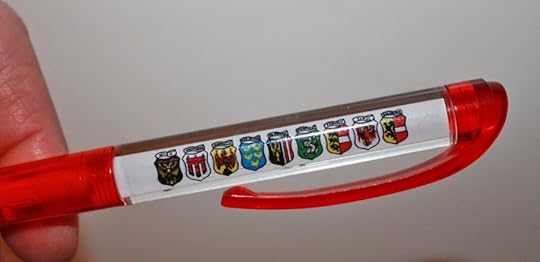
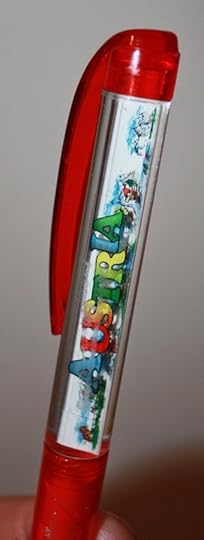 The word 'Austria' floats up and down as you tip the pen. Pretty cool.
The word 'Austria' floats up and down as you tip the pen. Pretty cool.

Next stop was Florence, Italy...

... and Venice. The gondola moves, too!


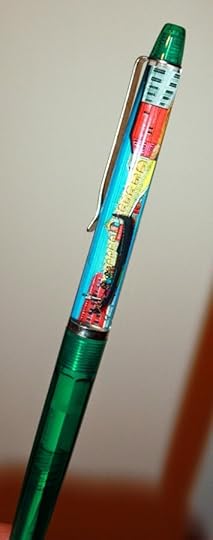

We visited the Leaning Tower of Pisa - one of the wonders of the world!

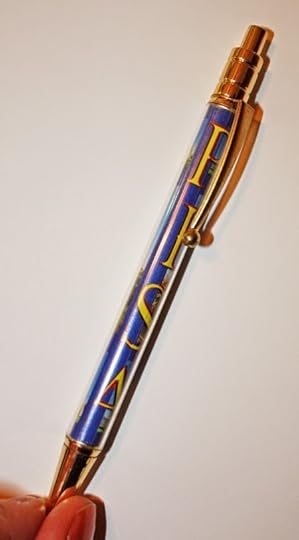
We went to other parts of Italy, then on to Nice, France.
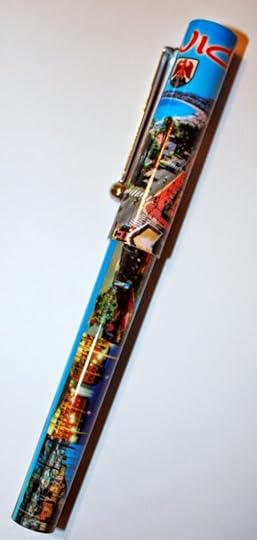


One of our favourite days was spent in Monaco.


So those are my pens from the first part of our Europe adventure. More to come...
We took a copy of the Never Leave Your Wingman book that I wrote with us to Europe, and the book has blogged about all the wonderful adventures we had. We have memories of the trip in photos and in other ways, too. We didn't want to buy a lot of things that we'd have to carry with us from country to country, so this is what I purchased as the first souvenir of our trip:

... a pen from Grossglockner National Park in Austria.
It seemed only right from that point on that I should continue buying a pen from each community or country that we visited - if we could find a pen specific to that place. My sister in Edmonton suggested that I write with each pen to show you how they work (or don't work), so here's my penned note about the Grossglockner pen:

Here's my pen from Austria:


 The word 'Austria' floats up and down as you tip the pen. Pretty cool.
The word 'Austria' floats up and down as you tip the pen. Pretty cool.
Next stop was Florence, Italy...


... and Venice. The gondola moves, too!




We visited the Leaning Tower of Pisa - one of the wonders of the world!


We went to other parts of Italy, then on to Nice, France.



One of our favourite days was spent in Monaco.


So those are my pens from the first part of our Europe adventure. More to come...
Published on September 13, 2014 13:17
August 20, 2014
The Introvert In Me
A friend drew my attention to this wonderful blog called Things You Should Know About Introverts.
It cracked me up.
And it explained a lot about me. Mostly.
For years, I harboured the notion that my natural curiosity and journalism training were the reasons that I prefer to stay in the background and observe.
It was only a few years ago that another friend described himself as an introvert. I laughed. That didn't make sense to me. This man talks to a crowd regularly as part of his job. I couldn't understand how he would think he is an introvert.
Then he informed me that I, too, am an introvert. "It's not about how you act. It's about where you get your energy from," he told me.
Oh.....
Turns out I'm an introvert because that label defines how I get energized, not how I behave.
Yep. That's me.
I like being alone. I like silence.
I sometimes like silence punctuated with my favourite music. No talking.
I need to recharge alone.
I can speak to a crowd and I can also talk to people and sell books all day at a trade show, but I need a nap afterwards - or at least a good long time of just sitting alone to decompress.
I have to force myself to hang around after an event to visit with folks.
And I am okay with people cancelling plans on me, but it doesn't happen that often because (1) I work from a home-based office, so there aren't that many parties going on around here; and (2) I've figured out how to accept invitations only for things I really want to attend. (You can do that when you're older and more established in your career.)
I am a writer. A creative person. There is always something going on in my head that keeps my wheels turning. I wouldn't exactly call my inner thoughts 'epic' - at least not all the time - but I do have some pretty good ideas just itching to get out and these are enough to keep me occupied most of the hours of every day.
I know I have a lot of company when it comes to introverts who are writers or involved in creative industries such as publishing. We folks get energized by standing back, watching the world, forming our opinions, presenting our views or expressions of creativity, then moving on to something else.
Happily alone. Most of the time.
It cracked me up.
And it explained a lot about me. Mostly.
For years, I harboured the notion that my natural curiosity and journalism training were the reasons that I prefer to stay in the background and observe.
It was only a few years ago that another friend described himself as an introvert. I laughed. That didn't make sense to me. This man talks to a crowd regularly as part of his job. I couldn't understand how he would think he is an introvert.
Then he informed me that I, too, am an introvert. "It's not about how you act. It's about where you get your energy from," he told me.
Oh.....
Turns out I'm an introvert because that label defines how I get energized, not how I behave.
Yep. That's me.
I like being alone. I like silence.
I sometimes like silence punctuated with my favourite music. No talking.
I need to recharge alone.
I can speak to a crowd and I can also talk to people and sell books all day at a trade show, but I need a nap afterwards - or at least a good long time of just sitting alone to decompress.
I have to force myself to hang around after an event to visit with folks.
And I am okay with people cancelling plans on me, but it doesn't happen that often because (1) I work from a home-based office, so there aren't that many parties going on around here; and (2) I've figured out how to accept invitations only for things I really want to attend. (You can do that when you're older and more established in your career.)
I am a writer. A creative person. There is always something going on in my head that keeps my wheels turning. I wouldn't exactly call my inner thoughts 'epic' - at least not all the time - but I do have some pretty good ideas just itching to get out and these are enough to keep me occupied most of the hours of every day.
I know I have a lot of company when it comes to introverts who are writers or involved in creative industries such as publishing. We folks get energized by standing back, watching the world, forming our opinions, presenting our views or expressions of creativity, then moving on to something else.
Happily alone. Most of the time.
Published on August 20, 2014 19:23
August 1, 2014
New-found Friends in St. John's, Newfoundland - Part 3
So there we were - on Day Four of our visit to St. John's, Newfoundland - standing in the foyer of a quaint restaurant called Classic Café East, not far from the bottom of Signal Hill.
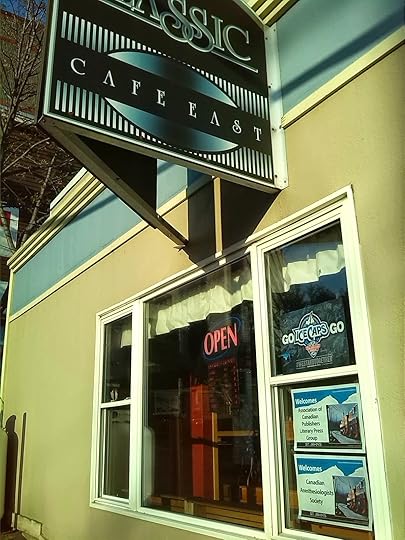
Al and I were looking at the menu, deciding whether we'd go into the restaurant to have some supper or not, when a man stopped in front of us, stuck his head into our line of vision and said, "You won't find better food for a better price anywhere in St. John's!"
"Alright, then," I said. "You've sold us. We're comin' in!" (Al and I had already seen some items on the menu for each of us, but his friendliness helped seal the deal.)
The waitress, meanwhile, was standing at the counter a few steps away, and started teasing the man. "What are you saying, John? You bothering these people?"
"No, he was trying to be helpful," I said. "We'll take him at his word. We're coming in to eat."
And then to continue the teasing, I added, "He might be your husband for all we know - saying such nice things."
At which point, the waitress - as she was seating us - yelled across several other tables to the back of the restaurant, where John had gone to sit: "Did you hear what she said, John? She said we could be married!"
Oh, geez. What have I done?
"No! No! That's not what I said!"
I was getting a bit flustered. The Newfies had turned the game on me.
"I said 'maybe' he's your husband - that's what we say in Saskatchewan when someone says such nice things - maybe you paid him to say such nice things."
Oh, my. This was more than I had anticipated.
(Note to self: Don't joke with a Newfie unless you're ready for a quick comeback.)
It all worked out well. We had a few more giggles with the folks in the restaurant, looked at the menu, accepted menu advice from the waitress, and placed our order.
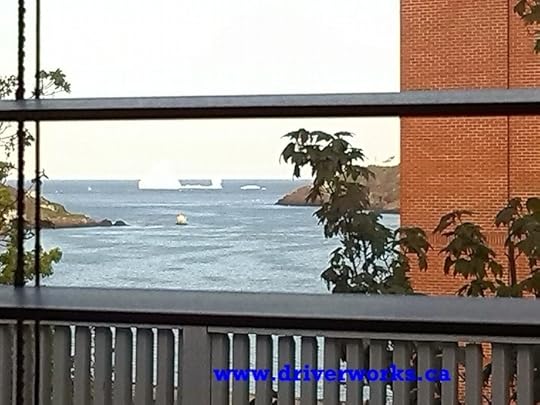 As we waited for our food, we enjoyed the view of the entrance to St. John's Harbour, which we could see from the restaurant's windows and patio. There were icebergs out there, and we Prairie folk loved looking at them.
As we waited for our food, we enjoyed the view of the entrance to St. John's Harbour, which we could see from the restaurant's windows and patio. There were icebergs out there, and we Prairie folk loved looking at them.
We weren't too daring the first time we ate at Classic Cafe East, but we went back a few times during our stay. We enjoyed some great Newfoundland-flavoured foods including seafood chowder with huge chunks of salmon in it, seafood au gratin (below left), and touton (below right), which is a deep-fried piece of bread dough that tastes like a donut/french toast combination. The locals eat touton with molasses. We don't care for the taste of molasses, so we used syrup. Pretty darn tasty.


We didn't try jig's dinner or cod tongues. They didn't appeal to us, but other people seem to like them.
On our third visit to the cafe, John was there again. This time, his actual wife, Helen, was there with him. They invited us to sit with them for lunch, and we enjoyed conversation which included their recommendations of sites we should visit in the area.
We had not booked a rental car before we got to St. John's. We incorrectly assumed we could rent one on the island, but every agency there was out of cars for the next few days, so we were getting around by taxi or by walking, we told them.
This prompted John to ask, "Are you up for a bit of a walk? I could drive you over to the lighthouse and you could walk back."
Sure, we said. That would be great. We could see the lighthouse - on the right tip of the harbour land in the photo above, and across the harbour from Signal Hill. That would be a pretty drive and a nice walk, we thought.
Silly us.
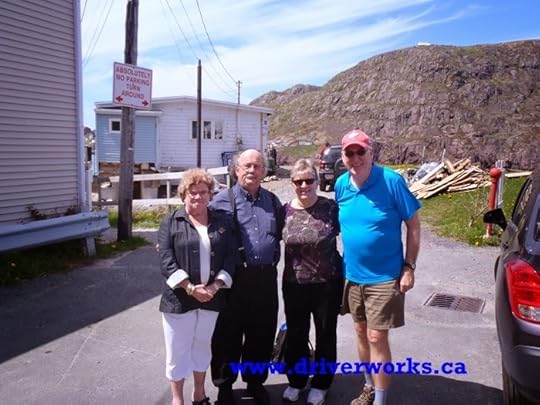 Here we are with our new Newfoundland friends, Helen and John Greenland, as they dropped us off just down the hill from the lighthouse at Fort Amherst, across the harbour from Signal Hill (a portion of which can be seen behind us).
Here we are with our new Newfoundland friends, Helen and John Greenland, as they dropped us off just down the hill from the lighthouse at Fort Amherst, across the harbour from Signal Hill (a portion of which can be seen behind us).
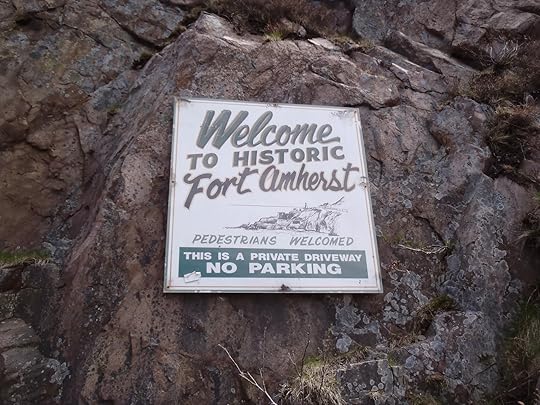 There were numerous homes along the rocks leading up to the lighthouse (below). We were intrigued, and wondered how these Easterners manoeuvred up and down those roads in the wintertime.
There were numerous homes along the rocks leading up to the lighthouse (below). We were intrigued, and wondered how these Easterners manoeuvred up and down those roads in the wintertime.
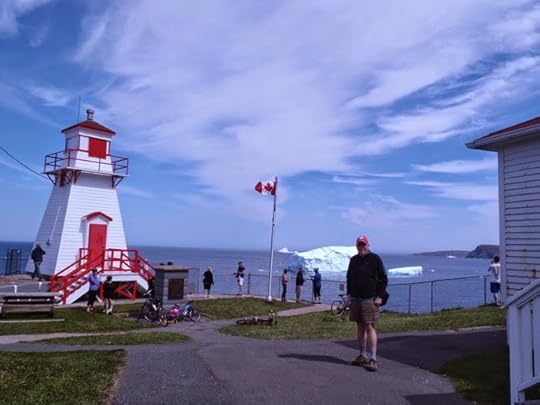 We had a nice view of some icebergs and Cape Spear (on the right), from the lighthouse area.
We had a nice view of some icebergs and Cape Spear (on the right), from the lighthouse area.
 We also enjoyed the scenery on what would become a longer-than-we-anticipated walk back to our hotel.
We also enjoyed the scenery on what would become a longer-than-we-anticipated walk back to our hotel.

The houses and boats on both sides of the harbour lend themselves to a typical Newfoundland scene on a beautiful sunny June day.
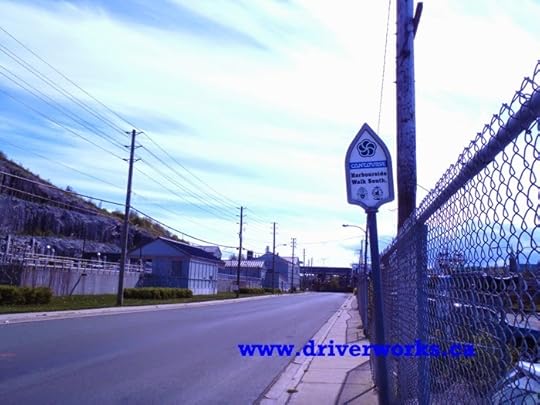 About 30 minutes into our walk, we came upon a sign that announced we were on "Harbourside Walk South'.Although a little tired, we were thankful to be taking this leisurely stroll along the harbour because we saw so many sights we are sure we would have missed if we had been driving.
About 30 minutes into our walk, we came upon a sign that announced we were on "Harbourside Walk South'.Although a little tired, we were thankful to be taking this leisurely stroll along the harbour because we saw so many sights we are sure we would have missed if we had been driving.
 The Canadian Navy used to store ammunition and other supplies in holes they made into the rocks along the harbour. Amazing.
The Canadian Navy used to store ammunition and other supplies in holes they made into the rocks along the harbour. Amazing.
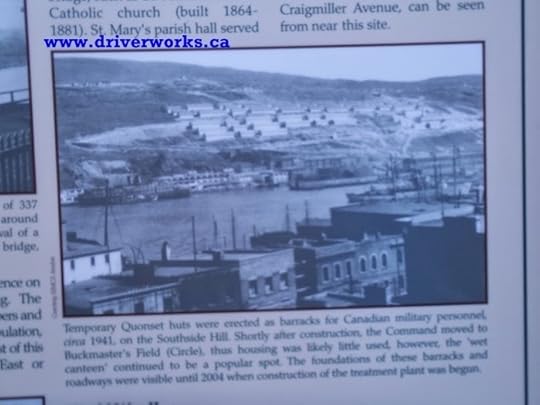 This photo from a display at the harbour shows the temporary quonset huts the Canadian military erected in 1941 on the Southside Hill. They weren't used much, but the sheer number of them took my breath away.
This photo from a display at the harbour shows the temporary quonset huts the Canadian military erected in 1941 on the Southside Hill. They weren't used much, but the sheer number of them took my breath away.
 The modern-day treatment plant was built on that spot in 2004.
The modern-day treatment plant was built on that spot in 2004.
We walked for more than one hour to get back to downtown St. John's, stopping at the Railroad Museum for a drink of water. We hadn't planned on the hike, so we hadn't packed anything with us, and we were impressed with the friendly young summer staff of the museum, who went out of their way to help these old(er), parched visitors.
After almost two hours, we had walked around almost the entire harbour. We were just a few blocks from the cafe where we started when we came across this humbling, beautiful memorial to Canadian Terry Fox, who lost his leg to bone cancer and vowed to run across Canada to raise funds for cancer research.
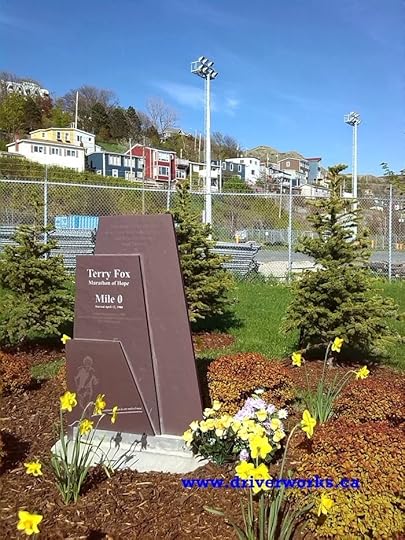 On April 12, 1980, Terry Fox dipped his artificial right leg into the Atlantic Ocean near this 'Mile 0' marker at St. John's Harbour and began running 42 kilometres (26 miles a day) through six provinces. See Terry Fox facts.
On April 12, 1980, Terry Fox dipped his artificial right leg into the Atlantic Ocean near this 'Mile 0' marker at St. John's Harbour and began running 42 kilometres (26 miles a day) through six provinces. See Terry Fox facts.
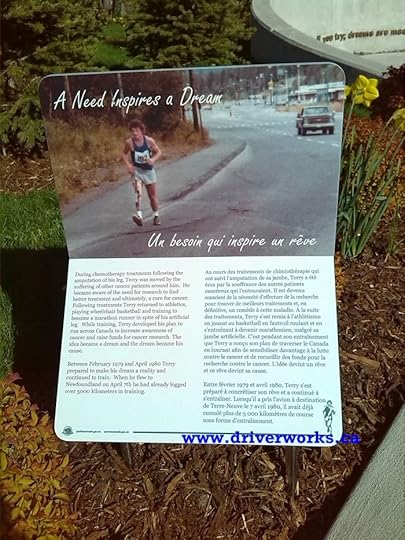 The details of Terry's life and his Marathon of Hope were honoured in several spots around this park.
The details of Terry's life and his Marathon of Hope were honoured in several spots around this park.
The larger-than-life statue of Terry Fox was inspiring.
 You can blame it on me just finishing up a two-hour walk, or the fact that my mother died of pancreatic and liver cancer in 2011, or that I am daily reminded of the strong eight-time cancer survivor Dionne Warner and so many others who fight against this ugly disease - but for whatever reasons, this statue got to me. I said a prayer for all who are affected by cancer, and I cried.
You can blame it on me just finishing up a two-hour walk, or the fact that my mother died of pancreatic and liver cancer in 2011, or that I am daily reminded of the strong eight-time cancer survivor Dionne Warner and so many others who fight against this ugly disease - but for whatever reasons, this statue got to me. I said a prayer for all who are affected by cancer, and I cried.
Four days later, after enjoying more of beautiful St. John's, Newfoundland and its surrounding area, I left a copy of my book The Sailor and the Christmas Trees at the restaurant for John and Helen Greenland. I wanted to thank John and Helen for their hospitality and show them a little bit more about the work of these 'mainlanders' whom they had befriended.
 That main event in this true story began in St. John's Harbour in November 1945, and we were thrilled to have seen the harbour and so much more during our stay and during our intriguing walk.
That main event in this true story began in St. John's Harbour in November 1945, and we were thrilled to have seen the harbour and so much more during our stay and during our intriguing walk.
We received an email from John and Helen after we returned home to Regina. They apologized for suggesting the extra-lengthy 'return walk from the Southside'.
No need to apologize, John. We saw a lot, learned a lot, and will cherish those memories forever.
As an aside, we were pleased to take copies of The Sailor and the Christmas Trees to the gift shop at The Rooms, an astounding building housing a multi-floor museum, archives and more in St. John's. The gift shop now sells copies of this fascinating true story, in the place where the story began. We are pleased. We hope you like it, too.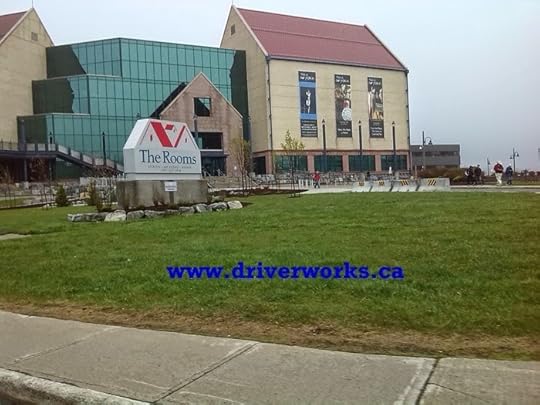

Al and I were looking at the menu, deciding whether we'd go into the restaurant to have some supper or not, when a man stopped in front of us, stuck his head into our line of vision and said, "You won't find better food for a better price anywhere in St. John's!"
"Alright, then," I said. "You've sold us. We're comin' in!" (Al and I had already seen some items on the menu for each of us, but his friendliness helped seal the deal.)
The waitress, meanwhile, was standing at the counter a few steps away, and started teasing the man. "What are you saying, John? You bothering these people?"
"No, he was trying to be helpful," I said. "We'll take him at his word. We're coming in to eat."
And then to continue the teasing, I added, "He might be your husband for all we know - saying such nice things."
At which point, the waitress - as she was seating us - yelled across several other tables to the back of the restaurant, where John had gone to sit: "Did you hear what she said, John? She said we could be married!"
Oh, geez. What have I done?
"No! No! That's not what I said!"
I was getting a bit flustered. The Newfies had turned the game on me.
"I said 'maybe' he's your husband - that's what we say in Saskatchewan when someone says such nice things - maybe you paid him to say such nice things."
Oh, my. This was more than I had anticipated.
(Note to self: Don't joke with a Newfie unless you're ready for a quick comeback.)
It all worked out well. We had a few more giggles with the folks in the restaurant, looked at the menu, accepted menu advice from the waitress, and placed our order.
 As we waited for our food, we enjoyed the view of the entrance to St. John's Harbour, which we could see from the restaurant's windows and patio. There were icebergs out there, and we Prairie folk loved looking at them.
As we waited for our food, we enjoyed the view of the entrance to St. John's Harbour, which we could see from the restaurant's windows and patio. There were icebergs out there, and we Prairie folk loved looking at them.We weren't too daring the first time we ate at Classic Cafe East, but we went back a few times during our stay. We enjoyed some great Newfoundland-flavoured foods including seafood chowder with huge chunks of salmon in it, seafood au gratin (below left), and touton (below right), which is a deep-fried piece of bread dough that tastes like a donut/french toast combination. The locals eat touton with molasses. We don't care for the taste of molasses, so we used syrup. Pretty darn tasty.


We didn't try jig's dinner or cod tongues. They didn't appeal to us, but other people seem to like them.
On our third visit to the cafe, John was there again. This time, his actual wife, Helen, was there with him. They invited us to sit with them for lunch, and we enjoyed conversation which included their recommendations of sites we should visit in the area.
We had not booked a rental car before we got to St. John's. We incorrectly assumed we could rent one on the island, but every agency there was out of cars for the next few days, so we were getting around by taxi or by walking, we told them.
This prompted John to ask, "Are you up for a bit of a walk? I could drive you over to the lighthouse and you could walk back."
Sure, we said. That would be great. We could see the lighthouse - on the right tip of the harbour land in the photo above, and across the harbour from Signal Hill. That would be a pretty drive and a nice walk, we thought.
Silly us.
 Here we are with our new Newfoundland friends, Helen and John Greenland, as they dropped us off just down the hill from the lighthouse at Fort Amherst, across the harbour from Signal Hill (a portion of which can be seen behind us).
Here we are with our new Newfoundland friends, Helen and John Greenland, as they dropped us off just down the hill from the lighthouse at Fort Amherst, across the harbour from Signal Hill (a portion of which can be seen behind us).  There were numerous homes along the rocks leading up to the lighthouse (below). We were intrigued, and wondered how these Easterners manoeuvred up and down those roads in the wintertime.
There were numerous homes along the rocks leading up to the lighthouse (below). We were intrigued, and wondered how these Easterners manoeuvred up and down those roads in the wintertime.  We had a nice view of some icebergs and Cape Spear (on the right), from the lighthouse area.
We had a nice view of some icebergs and Cape Spear (on the right), from the lighthouse area. We also enjoyed the scenery on what would become a longer-than-we-anticipated walk back to our hotel.
We also enjoyed the scenery on what would become a longer-than-we-anticipated walk back to our hotel.
The houses and boats on both sides of the harbour lend themselves to a typical Newfoundland scene on a beautiful sunny June day.
 About 30 minutes into our walk, we came upon a sign that announced we were on "Harbourside Walk South'.Although a little tired, we were thankful to be taking this leisurely stroll along the harbour because we saw so many sights we are sure we would have missed if we had been driving.
About 30 minutes into our walk, we came upon a sign that announced we were on "Harbourside Walk South'.Although a little tired, we were thankful to be taking this leisurely stroll along the harbour because we saw so many sights we are sure we would have missed if we had been driving. The Canadian Navy used to store ammunition and other supplies in holes they made into the rocks along the harbour. Amazing.
The Canadian Navy used to store ammunition and other supplies in holes they made into the rocks along the harbour. Amazing. This photo from a display at the harbour shows the temporary quonset huts the Canadian military erected in 1941 on the Southside Hill. They weren't used much, but the sheer number of them took my breath away.
This photo from a display at the harbour shows the temporary quonset huts the Canadian military erected in 1941 on the Southside Hill. They weren't used much, but the sheer number of them took my breath away.  The modern-day treatment plant was built on that spot in 2004.
The modern-day treatment plant was built on that spot in 2004.We walked for more than one hour to get back to downtown St. John's, stopping at the Railroad Museum for a drink of water. We hadn't planned on the hike, so we hadn't packed anything with us, and we were impressed with the friendly young summer staff of the museum, who went out of their way to help these old(er), parched visitors.
After almost two hours, we had walked around almost the entire harbour. We were just a few blocks from the cafe where we started when we came across this humbling, beautiful memorial to Canadian Terry Fox, who lost his leg to bone cancer and vowed to run across Canada to raise funds for cancer research.
 On April 12, 1980, Terry Fox dipped his artificial right leg into the Atlantic Ocean near this 'Mile 0' marker at St. John's Harbour and began running 42 kilometres (26 miles a day) through six provinces. See Terry Fox facts.
On April 12, 1980, Terry Fox dipped his artificial right leg into the Atlantic Ocean near this 'Mile 0' marker at St. John's Harbour and began running 42 kilometres (26 miles a day) through six provinces. See Terry Fox facts. The details of Terry's life and his Marathon of Hope were honoured in several spots around this park.
The details of Terry's life and his Marathon of Hope were honoured in several spots around this park.The larger-than-life statue of Terry Fox was inspiring.
 You can blame it on me just finishing up a two-hour walk, or the fact that my mother died of pancreatic and liver cancer in 2011, or that I am daily reminded of the strong eight-time cancer survivor Dionne Warner and so many others who fight against this ugly disease - but for whatever reasons, this statue got to me. I said a prayer for all who are affected by cancer, and I cried.
You can blame it on me just finishing up a two-hour walk, or the fact that my mother died of pancreatic and liver cancer in 2011, or that I am daily reminded of the strong eight-time cancer survivor Dionne Warner and so many others who fight against this ugly disease - but for whatever reasons, this statue got to me. I said a prayer for all who are affected by cancer, and I cried.Four days later, after enjoying more of beautiful St. John's, Newfoundland and its surrounding area, I left a copy of my book The Sailor and the Christmas Trees at the restaurant for John and Helen Greenland. I wanted to thank John and Helen for their hospitality and show them a little bit more about the work of these 'mainlanders' whom they had befriended.
 That main event in this true story began in St. John's Harbour in November 1945, and we were thrilled to have seen the harbour and so much more during our stay and during our intriguing walk.
That main event in this true story began in St. John's Harbour in November 1945, and we were thrilled to have seen the harbour and so much more during our stay and during our intriguing walk. We received an email from John and Helen after we returned home to Regina. They apologized for suggesting the extra-lengthy 'return walk from the Southside'.
No need to apologize, John. We saw a lot, learned a lot, and will cherish those memories forever.
As an aside, we were pleased to take copies of The Sailor and the Christmas Trees to the gift shop at The Rooms, an astounding building housing a multi-floor museum, archives and more in St. John's. The gift shop now sells copies of this fascinating true story, in the place where the story began. We are pleased. We hope you like it, too.

Published on August 01, 2014 17:23
July 25, 2014
Beautiful St. John's, NL - Sailors & icebergs - Part 2
When I wrote
The Sailor and the Christmas Trees
in 2012, I never imagined that I might someday see the spot in Newfoundland where the young John Hanlon went up a hill and cut down some trees to surprise his fellow shipmates on Christmas Day 1944.
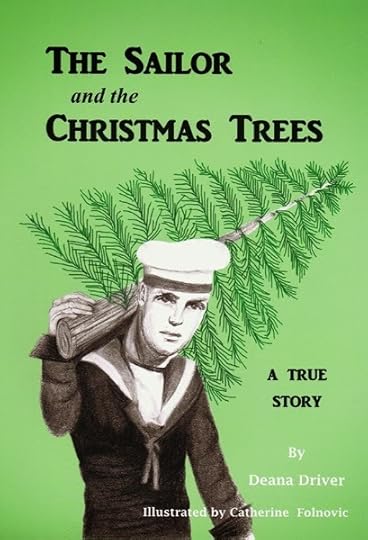
Yet it happened. In June 2014, I attended the Association of Canadian Publishers meeting in St. John's, to represent the Saskatchewan Publishers Group (of which I am on the board of directors). My husband (and DriverWorks Ink publisher partner) Al came along on that trip, and we had some great adventures.
One of my favourite moments was when I looked at St. John's Harbour and imagined what it must have been like for John Hanlon - a Prairie boy from Brandon, Manitoba - who had enlisted in the Royal Canadian Navy during the Second World War.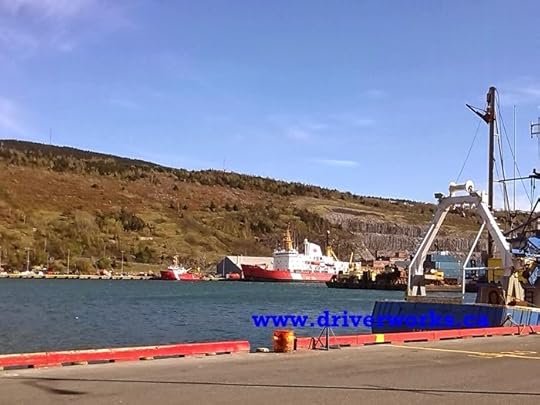 This is St. John's Harbour today.
This is St. John's Harbour today.
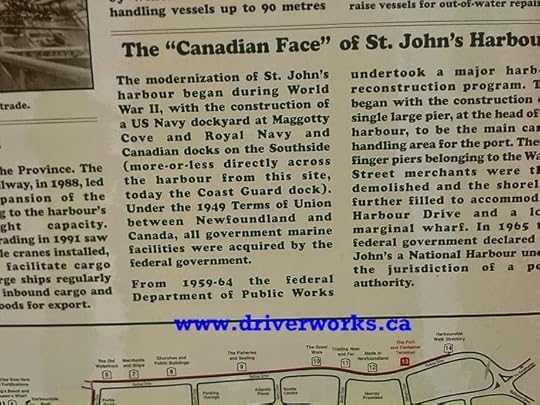 The site for the Canadian docks was directly across from where we were standing.
The site for the Canadian docks was directly across from where we were standing.
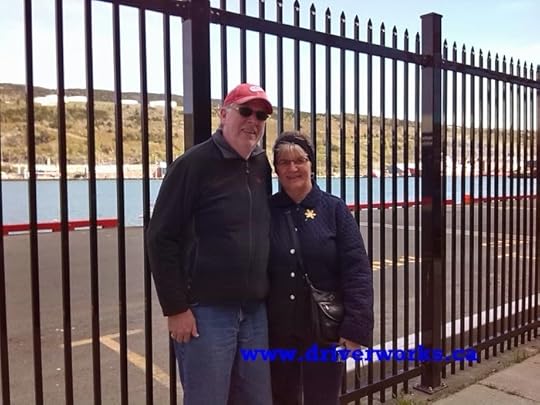
That hill behind us is likely the one that John and three of his friends climbed to cut down some trees in November 944. They hid the trees on their ship for almost a month, as the frigate sailed with the convoy to England, and then headed back to Canada. On Christmas Day 1944, in the middle of the Atlantic Ocean, John pulled out those trees and surprised the rest of the crew as well as some small children on another ship, who were coming from England to find safety in Canada.
What a nice story and what a neat experience to see that hill for myself! I was deeply moved.
 This photo on a boardwalk sign in St. John's Harbour shows a convoy preparing the leave St. John's Harbour during wartime.
This photo on a boardwalk sign in St. John's Harbour shows a convoy preparing the leave St. John's Harbour during wartime.

A German submarine surfaced in the harbour after surrender in May 1945.
Here's a fun fact for ya:
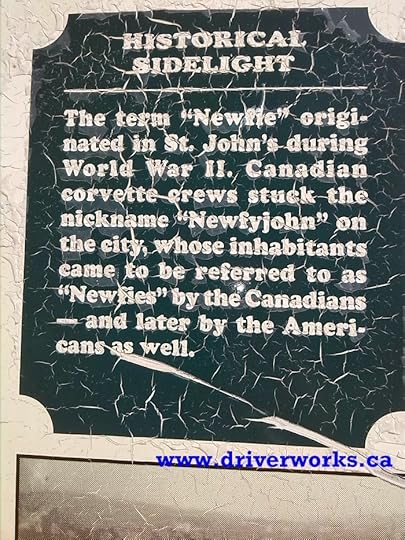 The Newfies have their own lingo and their own names for Prairie folks like me and Al.We were introduced as 'mainlanders'. "Either that," said a new Newfie friend, 'or we call you 'come from away'."
The Newfies have their own lingo and their own names for Prairie folks like me and Al.We were introduced as 'mainlanders'. "Either that," said a new Newfie friend, 'or we call you 'come from away'."
Makes sense to me!
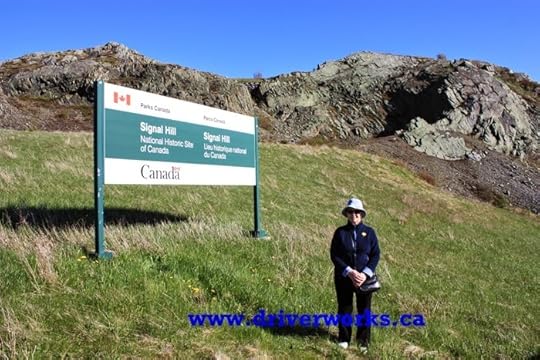 Signal Hill National Historic Park and Cabot Tower are among the most noted tourist attractions of St. John's.
Signal Hill National Historic Park and Cabot Tower are among the most noted tourist attractions of St. John's.
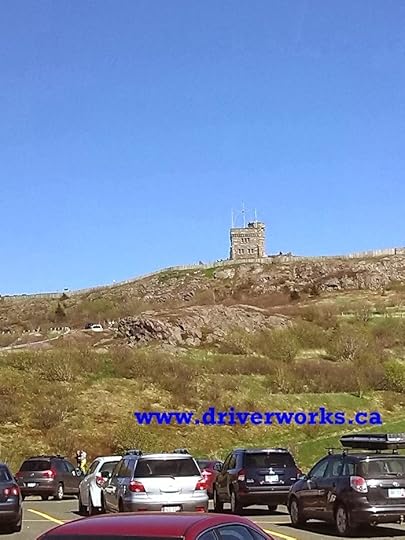 There's along long line-up to drive up the hill, and only a few parking spots on top, so be prepared for a hike - up and down!
There's along long line-up to drive up the hill, and only a few parking spots on top, so be prepared for a hike - up and down!
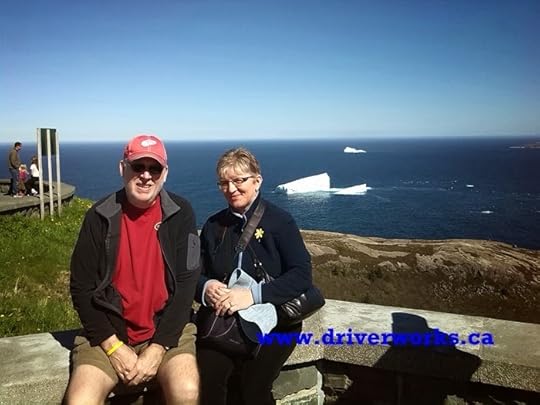 Beautiful views make this trek worthwhile. We saw our first-ever view of icebergs from the Hill in early June. A large chunk of ice had broken off a glacier in Greenland, we were told, and this was causing more icebergs to appear off the coast of Newfoundland than in a normal year.
Beautiful views make this trek worthwhile. We saw our first-ever view of icebergs from the Hill in early June. A large chunk of ice had broken off a glacier in Greenland, we were told, and this was causing more icebergs to appear off the coast of Newfoundland than in a normal year.
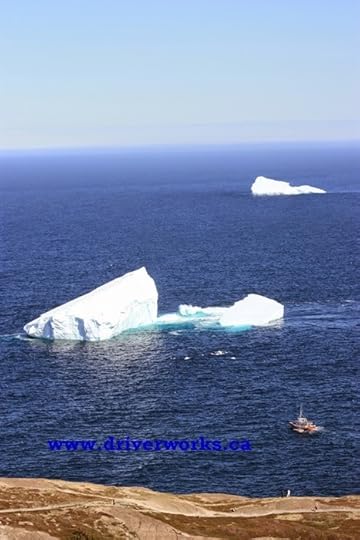 A few days later, we took a tour on that boat to see the icebergs up close and personal.
A few days later, we took a tour on that boat to see the icebergs up close and personal.
 These photos are the view looking back at parts of St. John's as we left the harbour.
These photos are the view looking back at parts of St. John's as we left the harbour.

 As we approached the icebergs closest to the Harbour, we were surprised and a little freaked out to see two kayakers paddling IN BETWEEN the two pieces of this large berg!
As we approached the icebergs closest to the Harbour, we were surprised and a little freaked out to see two kayakers paddling IN BETWEEN the two pieces of this large berg!
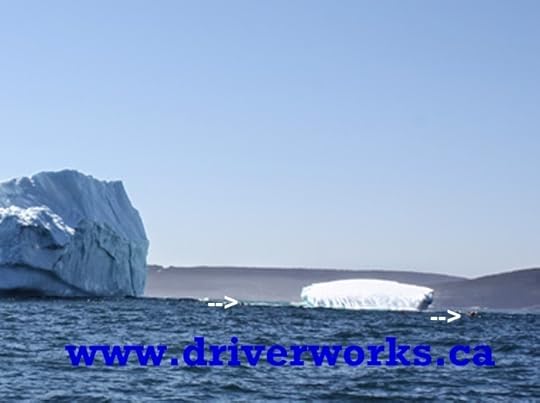 See them? Follow my arrows.A Coast Guard staff person who worked part-time on the tour boat told us this is a very dangerous activity since bergs may look stable but are constantly moving. Only one-tenth of an iceberg is visible above water. Imagine how big that thing is!
See them? Follow my arrows.A Coast Guard staff person who worked part-time on the tour boat told us this is a very dangerous activity since bergs may look stable but are constantly moving. Only one-tenth of an iceberg is visible above water. Imagine how big that thing is!
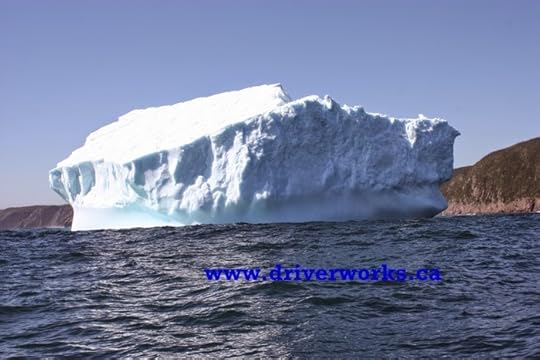 Mother Nature proved that point about 15 minutes later, as we circled the biggest berg from a distance...
Mother Nature proved that point about 15 minutes later, as we circled the biggest berg from a distance...
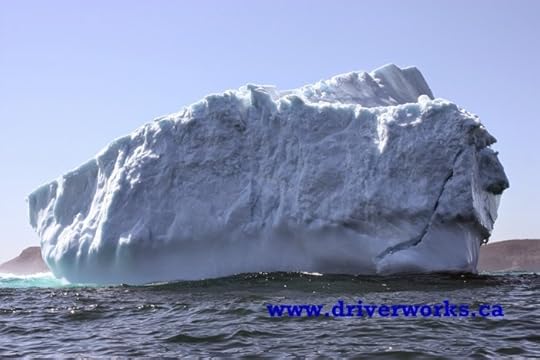 ...we saw a large crack on the one end.
...we saw a large crack on the one end.
 Seconds later, that piece - as large as our house and weighing tons, because the ice is so dense - broke off and hit the water. It would have crushed the kayakers. "We'd be pulling their bodies out," the one Coast Guard worker said. He also told us that he had recently seen a man walking on an iceberg ... with his dog. Some people are just plain dumb.
Seconds later, that piece - as large as our house and weighing tons, because the ice is so dense - broke off and hit the water. It would have crushed the kayakers. "We'd be pulling their bodies out," the one Coast Guard worker said. He also told us that he had recently seen a man walking on an iceberg ... with his dog. Some people are just plain dumb.
 Cape Spear is the most easterly point in North America. Next stop - Ireland!We saw it from the ocean, then visited it by land a few days later.
Cape Spear is the most easterly point in North America. Next stop - Ireland!We saw it from the ocean, then visited it by land a few days later.
 Icebergs may be dangerous up close, but they certainly have a beauty to them.
Icebergs may be dangerous up close, but they certainly have a beauty to them.
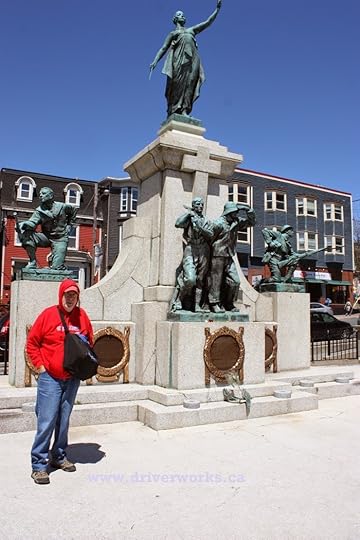 We stopped to admire a statue honouring those who have died in various battles.
We stopped to admire a statue honouring those who have died in various battles.
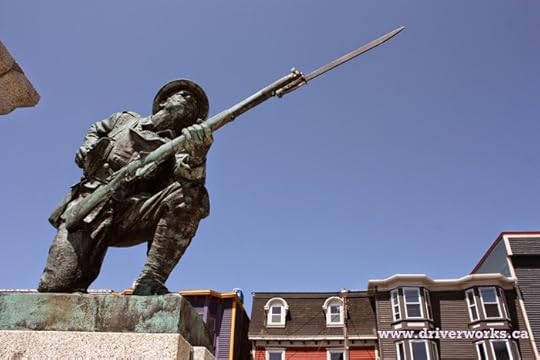 Once again, I thought of John Hanlon, and the experiences he must have had fighting for our freedom.
Once again, I thought of John Hanlon, and the experiences he must have had fighting for our freedom.
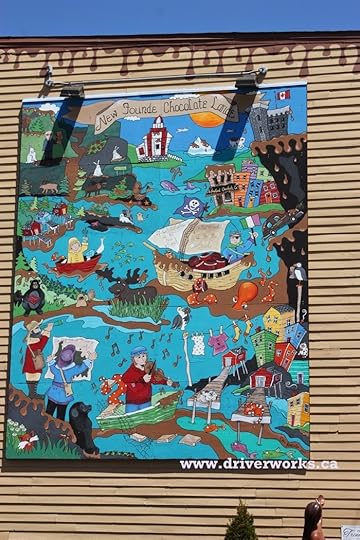 This beautiful wall mural depicting some of the colourfulness of St. John's, Newfoundland.
This beautiful wall mural depicting some of the colourfulness of St. John's, Newfoundland.
Part 3 of my Newfoundland blogs.

Yet it happened. In June 2014, I attended the Association of Canadian Publishers meeting in St. John's, to represent the Saskatchewan Publishers Group (of which I am on the board of directors). My husband (and DriverWorks Ink publisher partner) Al came along on that trip, and we had some great adventures.
One of my favourite moments was when I looked at St. John's Harbour and imagined what it must have been like for John Hanlon - a Prairie boy from Brandon, Manitoba - who had enlisted in the Royal Canadian Navy during the Second World War.
 This is St. John's Harbour today.
This is St. John's Harbour today. The site for the Canadian docks was directly across from where we were standing.
The site for the Canadian docks was directly across from where we were standing. 
That hill behind us is likely the one that John and three of his friends climbed to cut down some trees in November 944. They hid the trees on their ship for almost a month, as the frigate sailed with the convoy to England, and then headed back to Canada. On Christmas Day 1944, in the middle of the Atlantic Ocean, John pulled out those trees and surprised the rest of the crew as well as some small children on another ship, who were coming from England to find safety in Canada.
What a nice story and what a neat experience to see that hill for myself! I was deeply moved.
 This photo on a boardwalk sign in St. John's Harbour shows a convoy preparing the leave St. John's Harbour during wartime.
This photo on a boardwalk sign in St. John's Harbour shows a convoy preparing the leave St. John's Harbour during wartime.
A German submarine surfaced in the harbour after surrender in May 1945.
Here's a fun fact for ya:
 The Newfies have their own lingo and their own names for Prairie folks like me and Al.We were introduced as 'mainlanders'. "Either that," said a new Newfie friend, 'or we call you 'come from away'."
The Newfies have their own lingo and their own names for Prairie folks like me and Al.We were introduced as 'mainlanders'. "Either that," said a new Newfie friend, 'or we call you 'come from away'."Makes sense to me!
 Signal Hill National Historic Park and Cabot Tower are among the most noted tourist attractions of St. John's.
Signal Hill National Historic Park and Cabot Tower are among the most noted tourist attractions of St. John's.
 There's along long line-up to drive up the hill, and only a few parking spots on top, so be prepared for a hike - up and down!
There's along long line-up to drive up the hill, and only a few parking spots on top, so be prepared for a hike - up and down! Beautiful views make this trek worthwhile. We saw our first-ever view of icebergs from the Hill in early June. A large chunk of ice had broken off a glacier in Greenland, we were told, and this was causing more icebergs to appear off the coast of Newfoundland than in a normal year.
Beautiful views make this trek worthwhile. We saw our first-ever view of icebergs from the Hill in early June. A large chunk of ice had broken off a glacier in Greenland, we were told, and this was causing more icebergs to appear off the coast of Newfoundland than in a normal year.  A few days later, we took a tour on that boat to see the icebergs up close and personal.
A few days later, we took a tour on that boat to see the icebergs up close and personal.  These photos are the view looking back at parts of St. John's as we left the harbour.
These photos are the view looking back at parts of St. John's as we left the harbour.
 As we approached the icebergs closest to the Harbour, we were surprised and a little freaked out to see two kayakers paddling IN BETWEEN the two pieces of this large berg!
As we approached the icebergs closest to the Harbour, we were surprised and a little freaked out to see two kayakers paddling IN BETWEEN the two pieces of this large berg! See them? Follow my arrows.A Coast Guard staff person who worked part-time on the tour boat told us this is a very dangerous activity since bergs may look stable but are constantly moving. Only one-tenth of an iceberg is visible above water. Imagine how big that thing is!
See them? Follow my arrows.A Coast Guard staff person who worked part-time on the tour boat told us this is a very dangerous activity since bergs may look stable but are constantly moving. Only one-tenth of an iceberg is visible above water. Imagine how big that thing is! Mother Nature proved that point about 15 minutes later, as we circled the biggest berg from a distance...
Mother Nature proved that point about 15 minutes later, as we circled the biggest berg from a distance... ...we saw a large crack on the one end.
...we saw a large crack on the one end. Seconds later, that piece - as large as our house and weighing tons, because the ice is so dense - broke off and hit the water. It would have crushed the kayakers. "We'd be pulling their bodies out," the one Coast Guard worker said. He also told us that he had recently seen a man walking on an iceberg ... with his dog. Some people are just plain dumb.
Seconds later, that piece - as large as our house and weighing tons, because the ice is so dense - broke off and hit the water. It would have crushed the kayakers. "We'd be pulling their bodies out," the one Coast Guard worker said. He also told us that he had recently seen a man walking on an iceberg ... with his dog. Some people are just plain dumb. Cape Spear is the most easterly point in North America. Next stop - Ireland!We saw it from the ocean, then visited it by land a few days later.
Cape Spear is the most easterly point in North America. Next stop - Ireland!We saw it from the ocean, then visited it by land a few days later. Icebergs may be dangerous up close, but they certainly have a beauty to them.
Icebergs may be dangerous up close, but they certainly have a beauty to them. We stopped to admire a statue honouring those who have died in various battles.
We stopped to admire a statue honouring those who have died in various battles. Once again, I thought of John Hanlon, and the experiences he must have had fighting for our freedom.
Once again, I thought of John Hanlon, and the experiences he must have had fighting for our freedom. This beautiful wall mural depicting some of the colourfulness of St. John's, Newfoundland.
This beautiful wall mural depicting some of the colourfulness of St. John's, Newfoundland. Part 3 of my Newfoundland blogs.
Published on July 25, 2014 22:02



